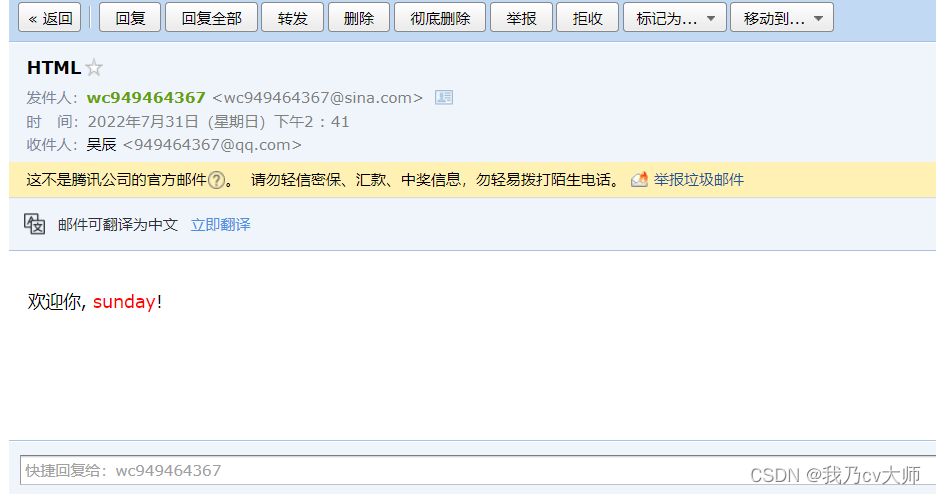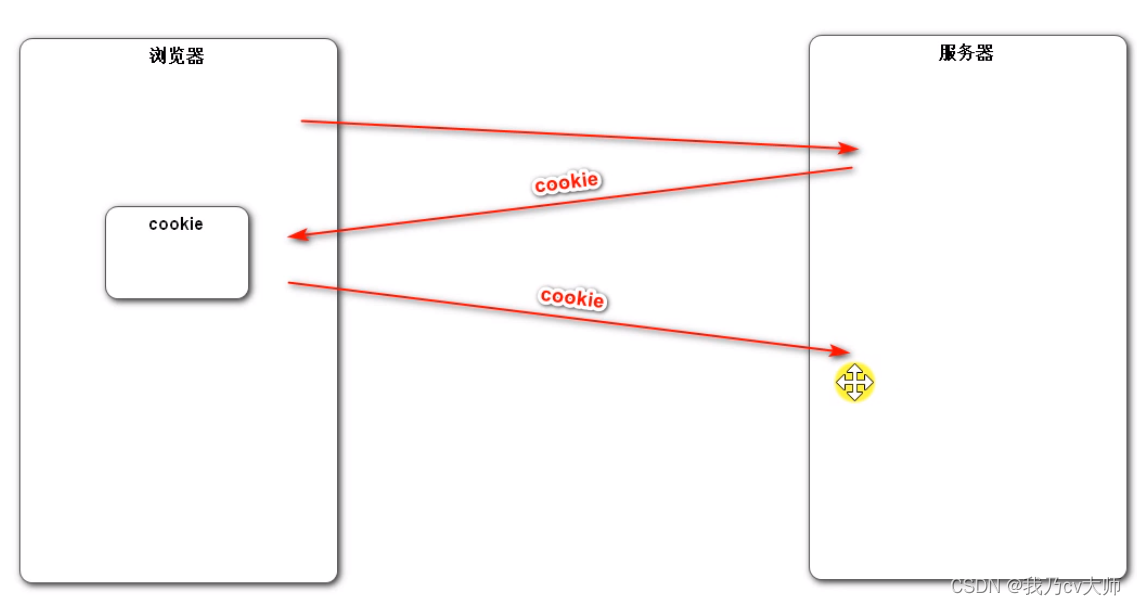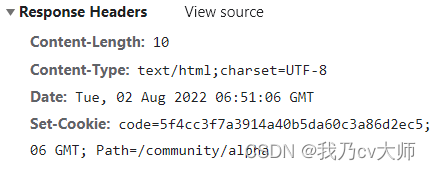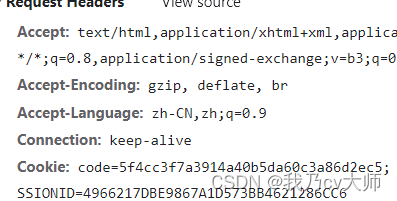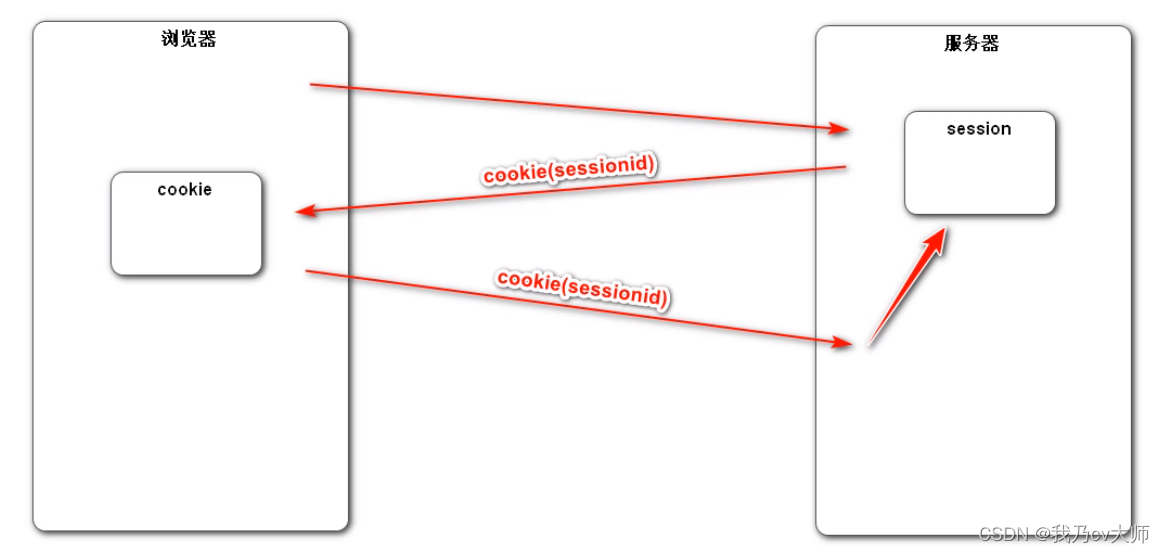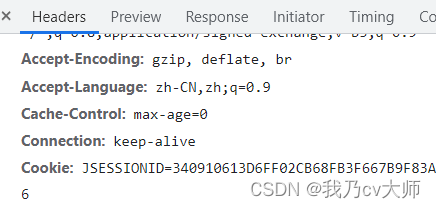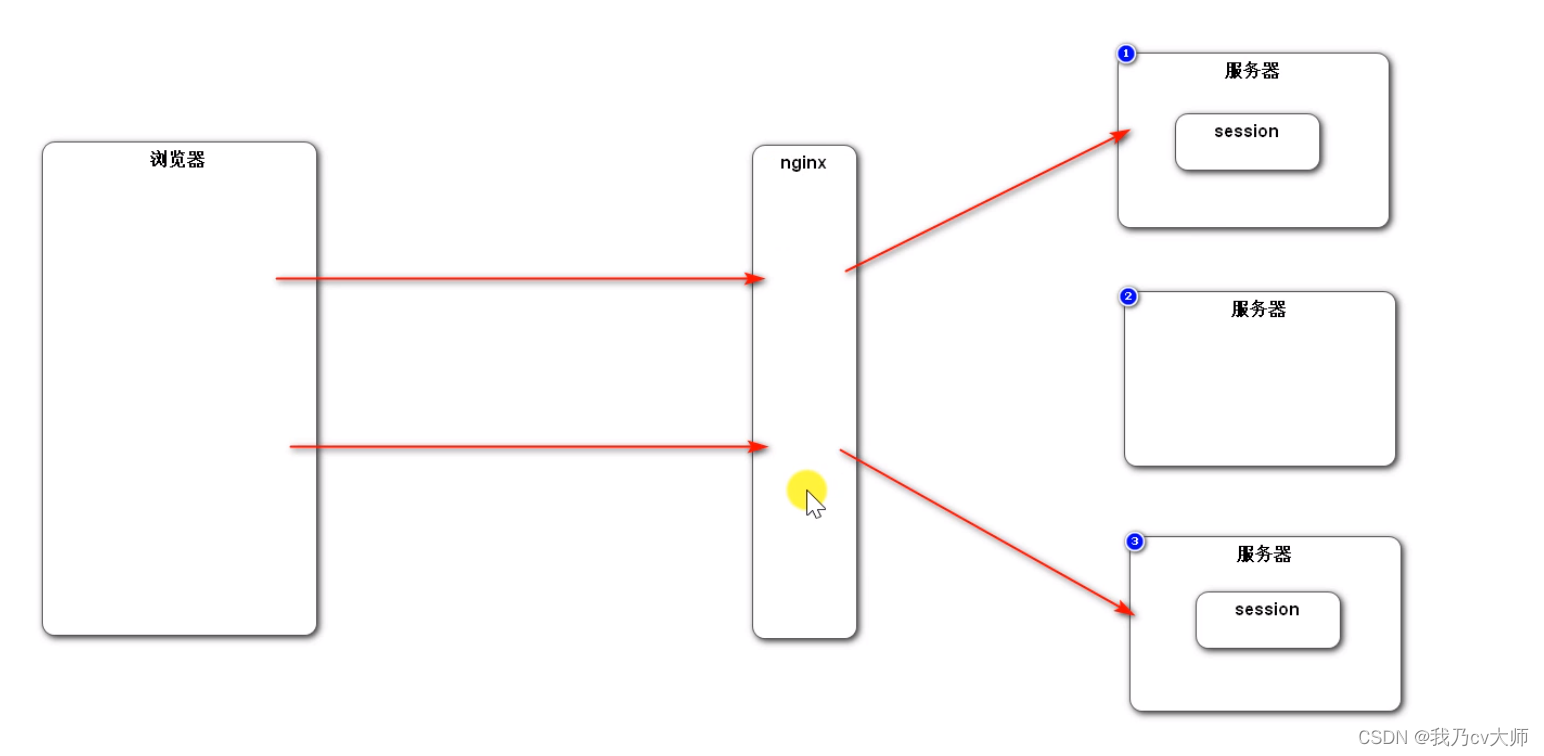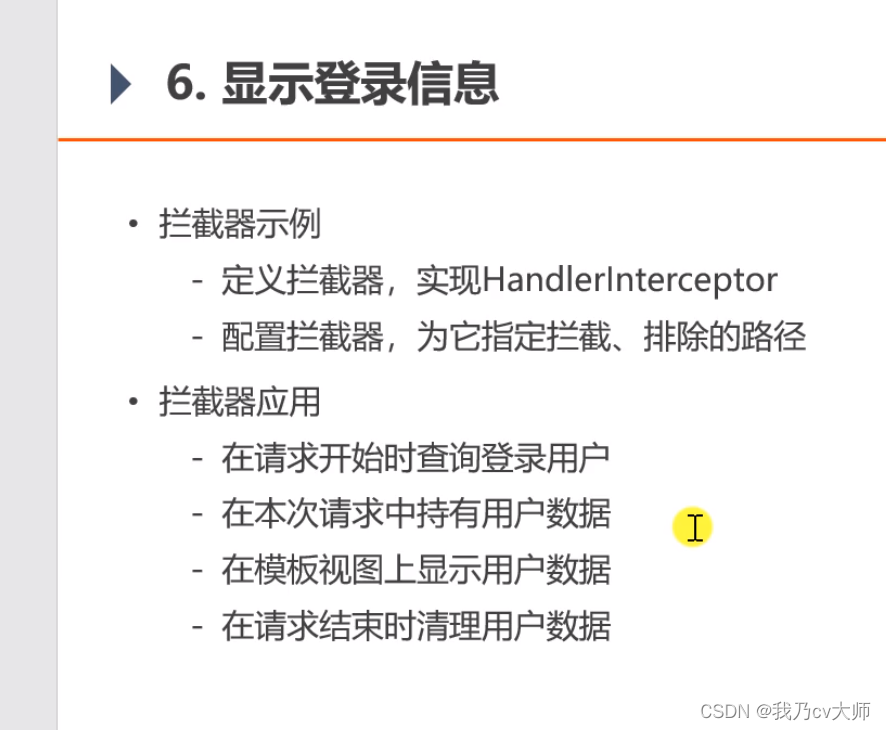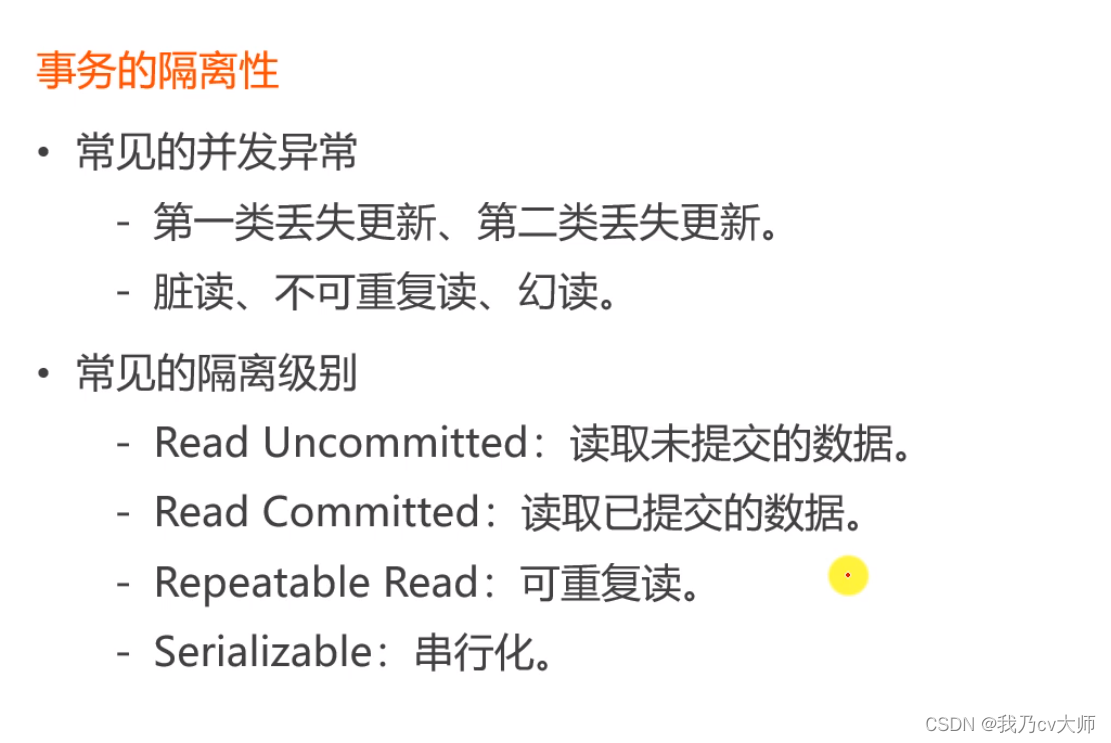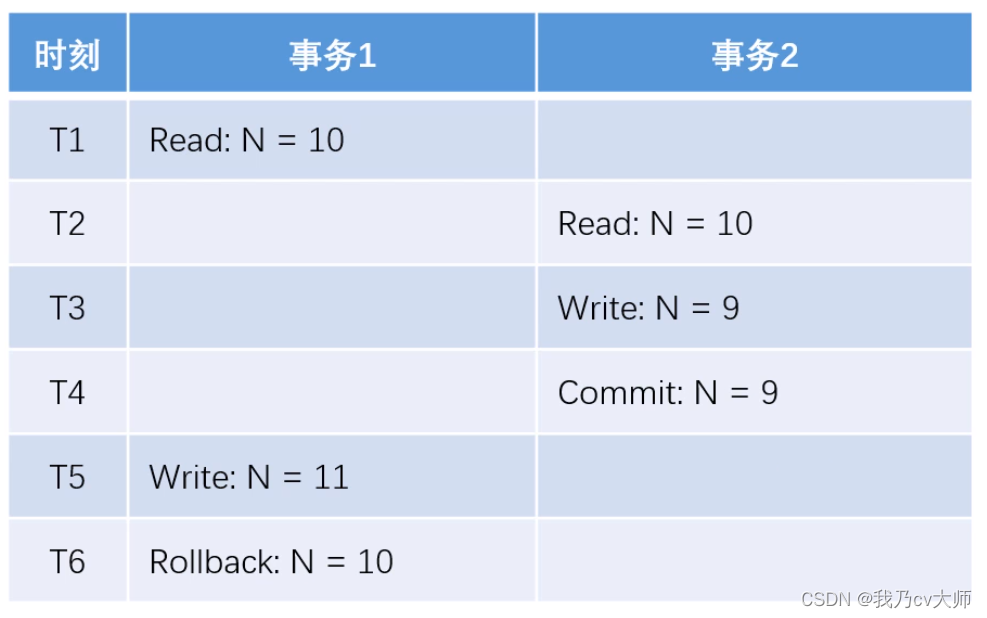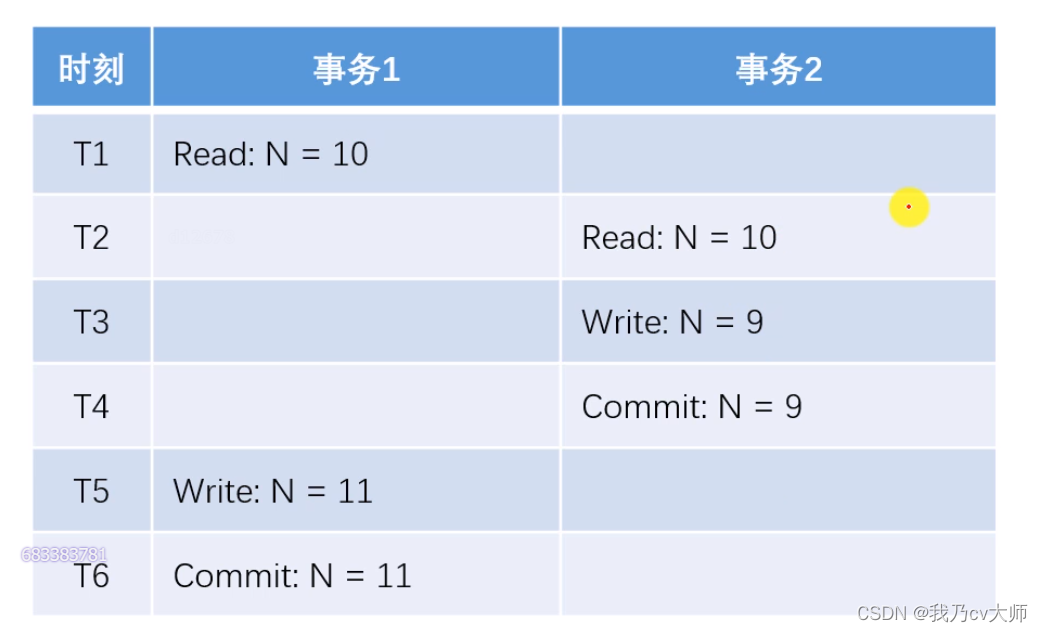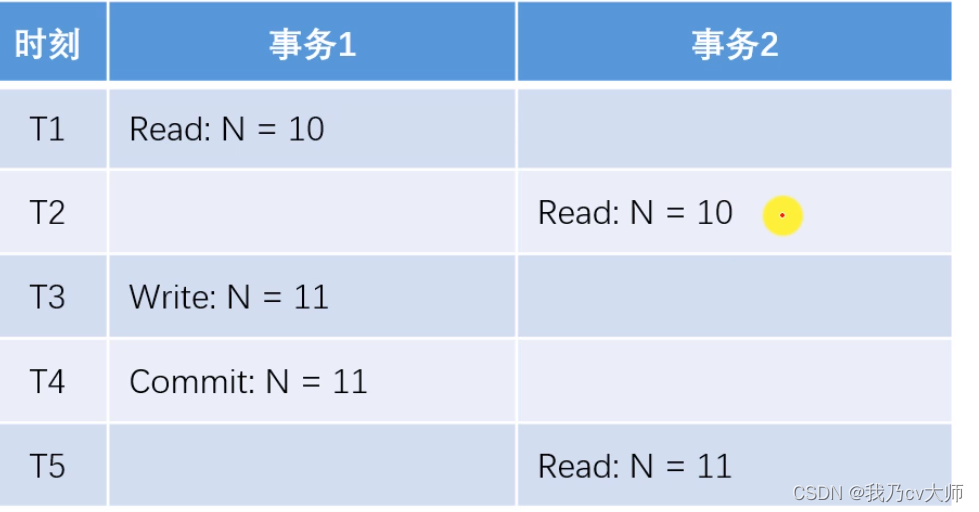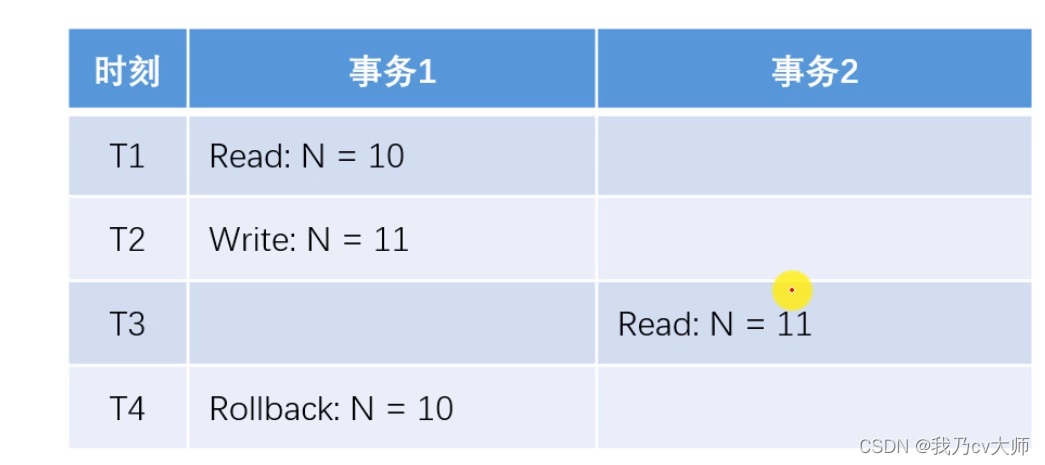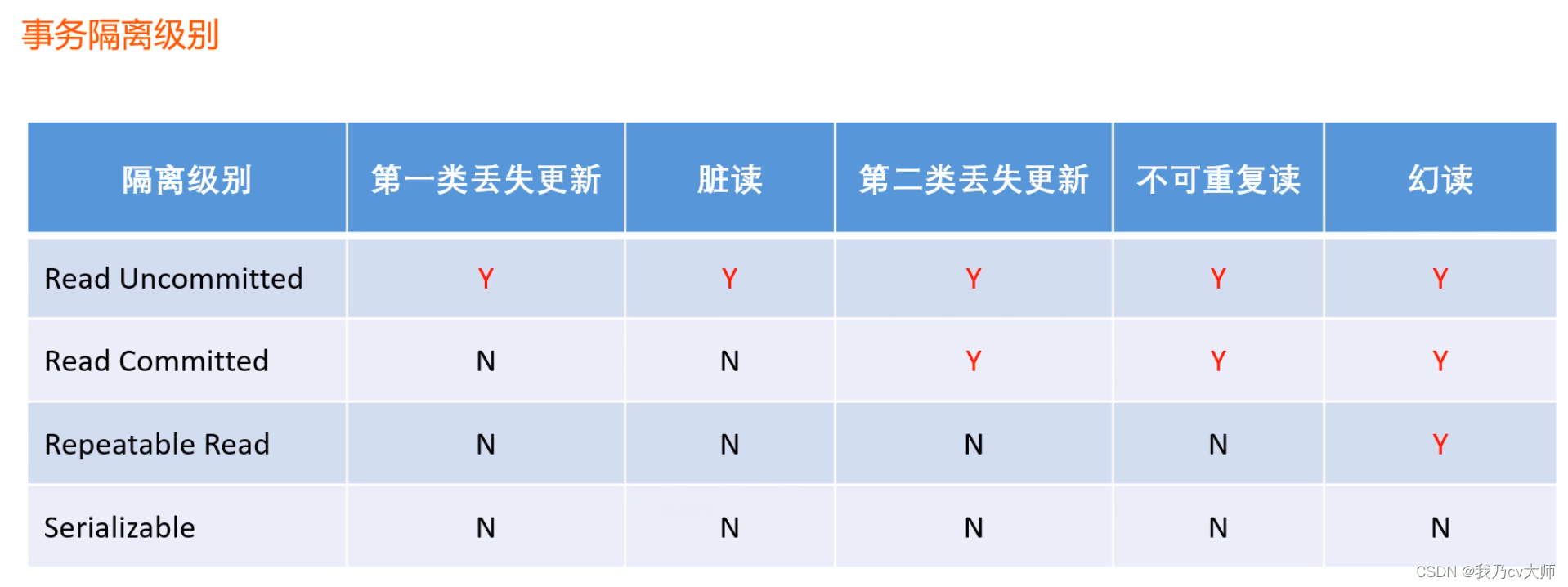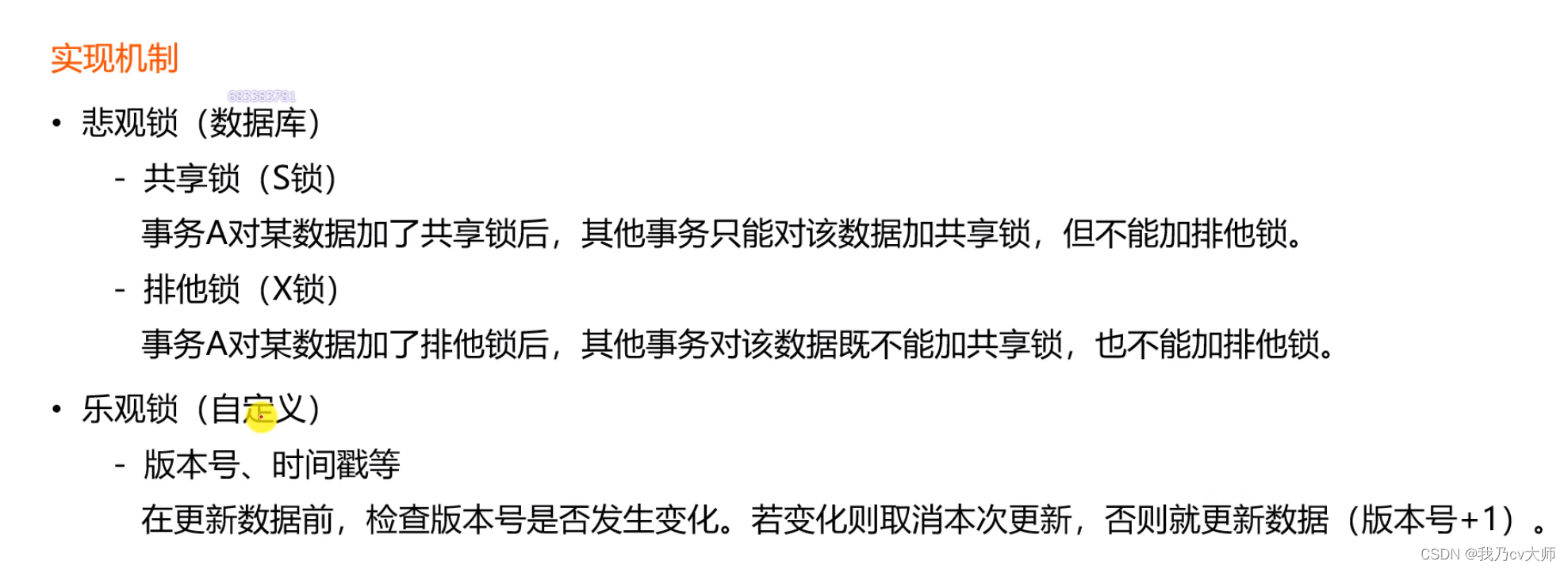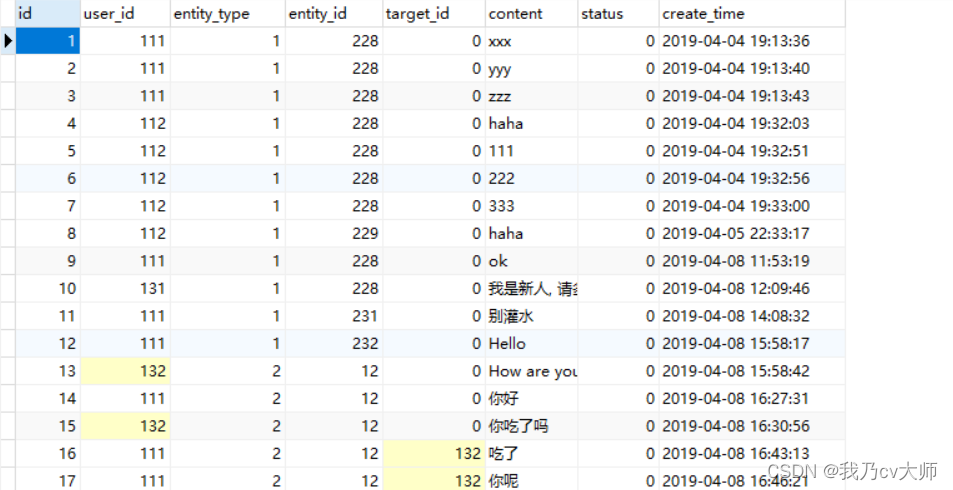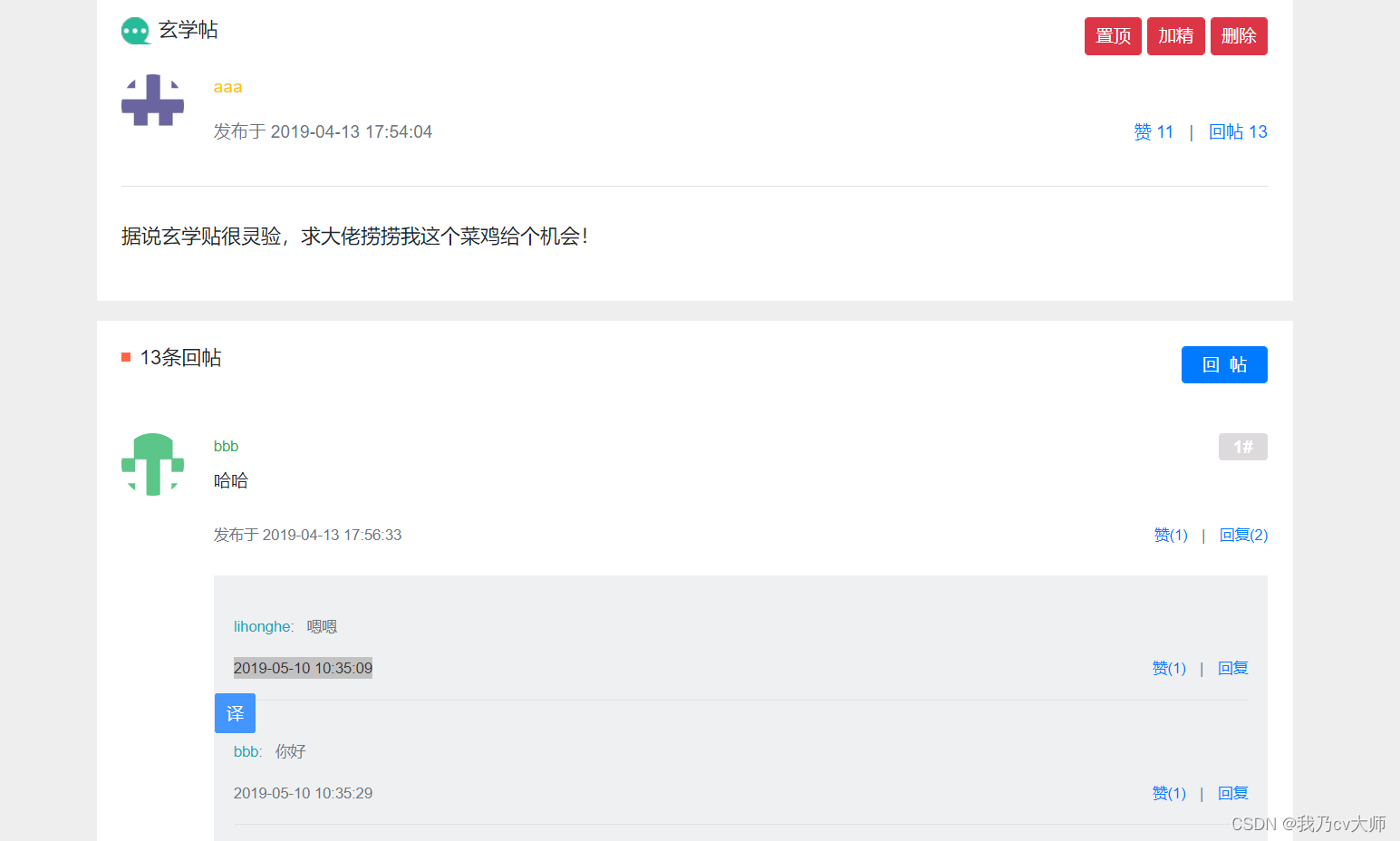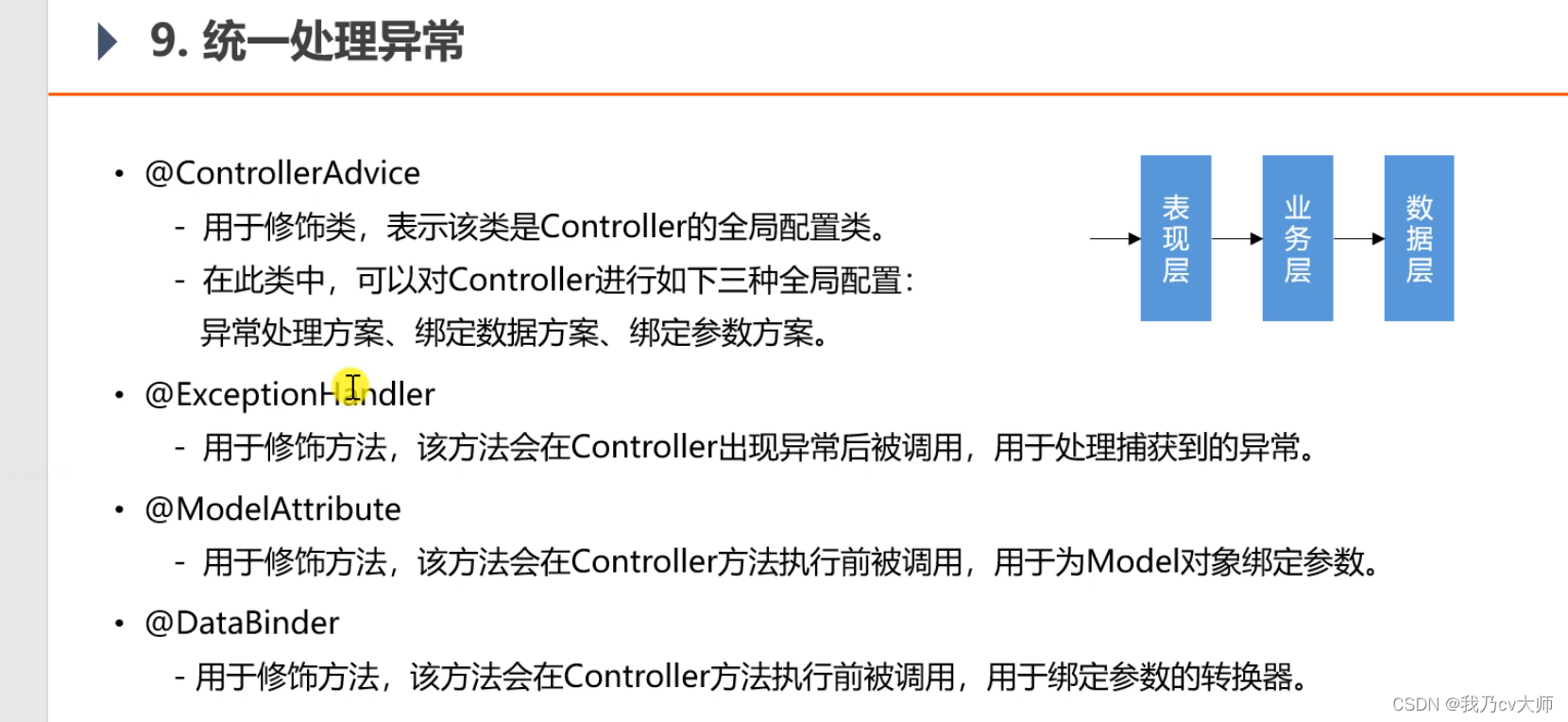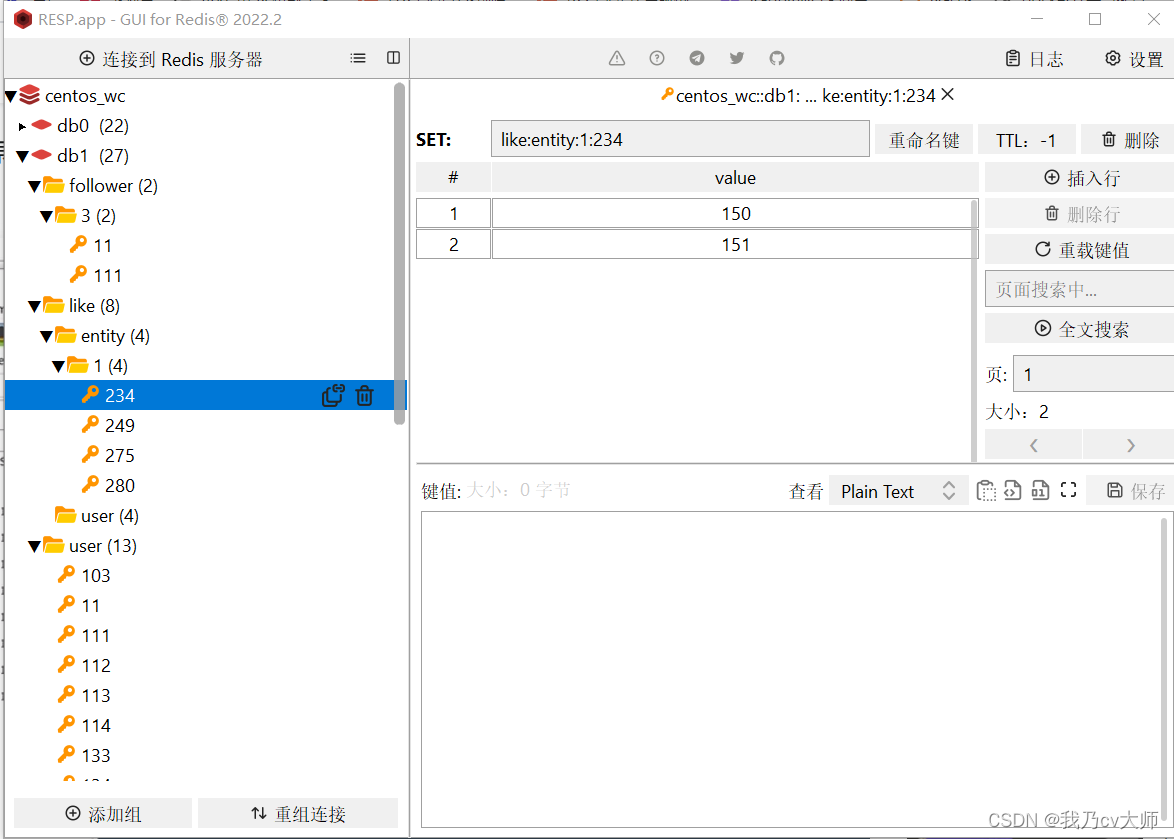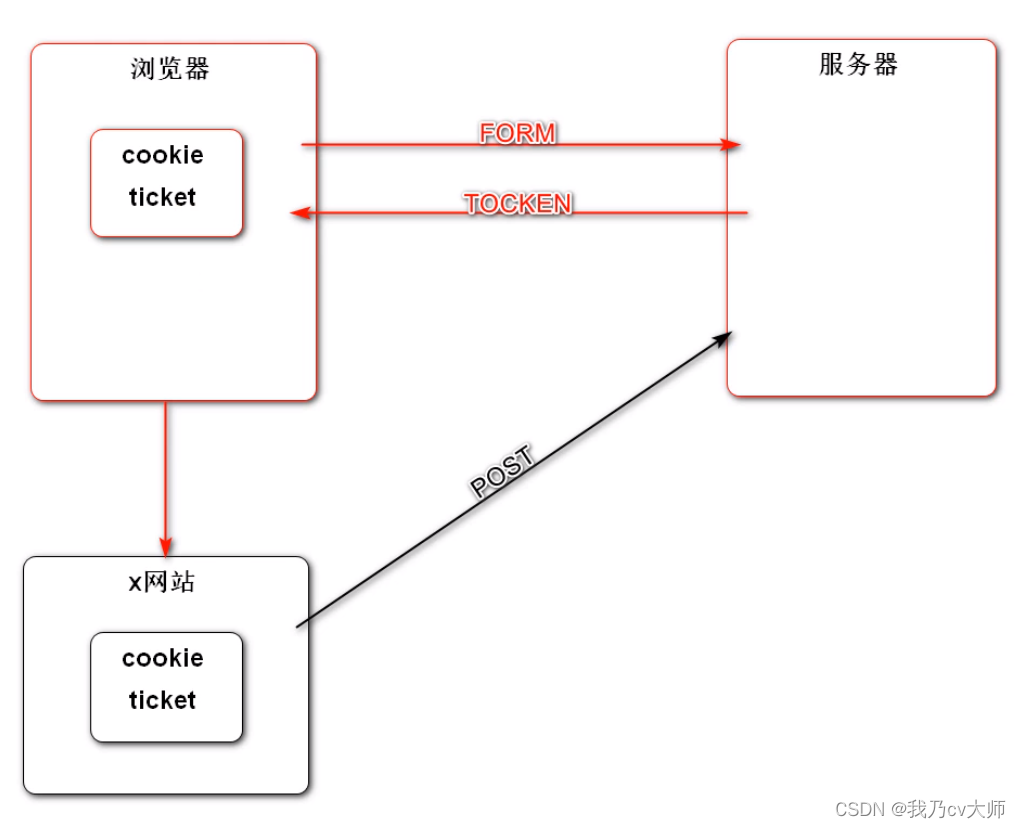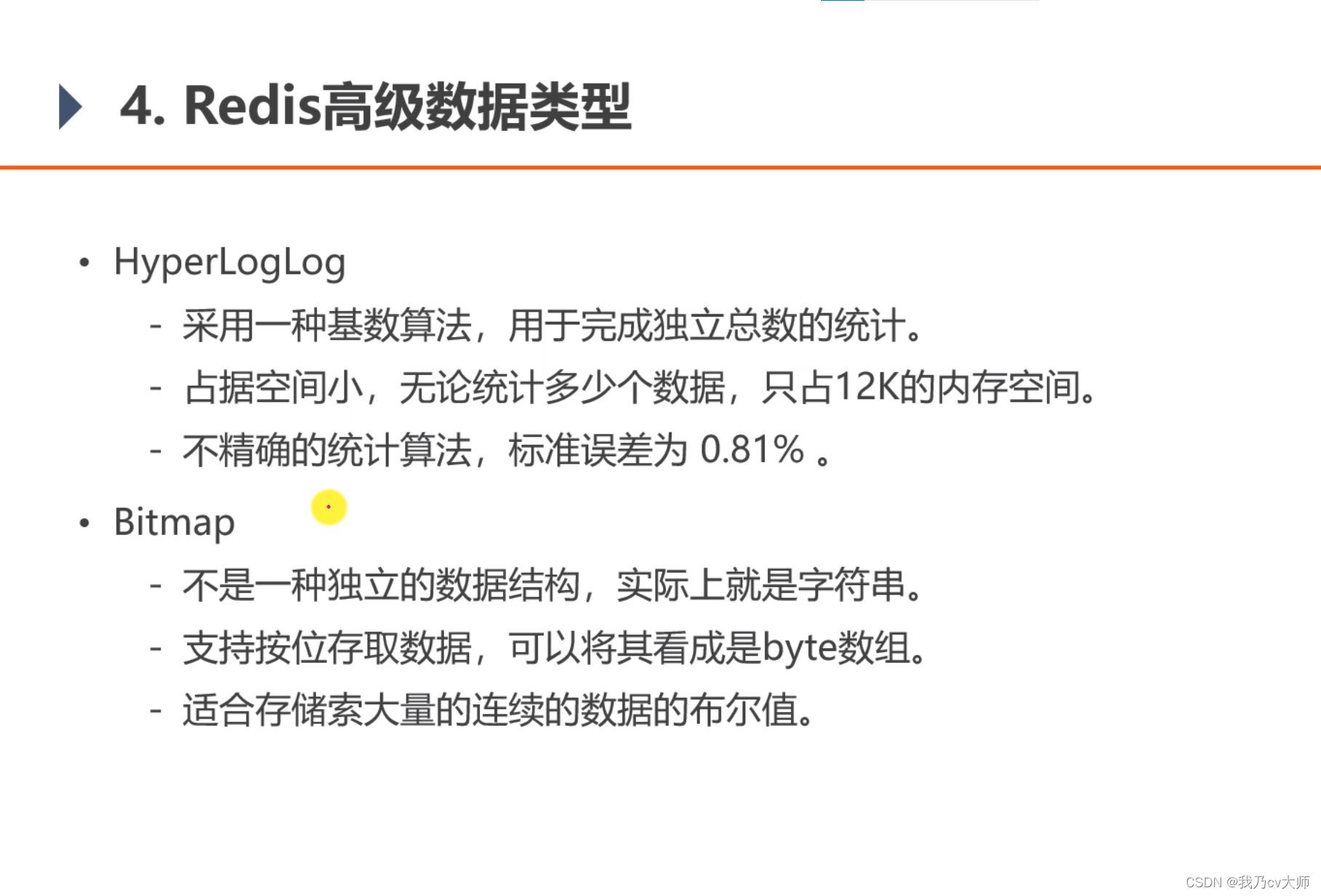个人记录一下觉得有意思的功能模块
项目做完一点心得和体会:
这个项目用来缓存机制,和异步处理模式,提高了服务器的响应时间。
为了应付短时间内大量的http请求,服务端通常的做法有以下4点:
- 使用HTTP的100 Continue状态码,让客户端在发送请求头后等待服务端的确认,如果服务端认为请求头合法,就返回100 Continue,让客户端继续发送请求体,否则返回错误码,避免客户端发送无效的数据
- 使用负载均衡器,将请求分发到不同的服务器上,减轻单个服务器的压力。
- 使用缓存机制,将一些静态资源或者常用数据缓存起来,减少对服务器的访问。
- 使用异步处理模式,将一些耗时的操作放到后台线程中执行,避免阻塞主线程。
目录
5.2 重写 prehandle,posthandle等方法
12、使用redis实现点赞功能,关注功能,对登陆模块进行优化
1.发送邮件(包括html页面)
1.1 导入maven依赖
发送邮件的功能封装在spring中,可以直接调用,首先导入相应的依赖
<dependency>
<groupId>org.springframework.boot</groupId>
<artifactId>spring-boot-starter-mail</artifactId>
<version>2.1.5.RELEASE</version>
</dependency>1.2 修改配置文件
再修改一下application.properties配置文件,加入以下内容
# MailProperties
spring.mail.host=smtp.sina.com
spring.mail.port=465
spring.mail.username=你自己的邮箱地址
spring.mail.password=邮箱的授权码
spring.mail.protocol=smtps
spring.mail.properties.mail.smtp.ssl.enable=true
1.3 编写邮件发送工具类
好了,接下来我们开始写一下发送邮件的工具类MailClient
@Component
public class MailClient {
private static final Logger logger = LoggerFactory.getLogger(MailClient.class);
@Autowired
private JavaMailSender mailSender;
@Value("${spring.mail.username}")
private String from;
public void sendMail(String to, String subject, String content) {
try {
MimeMessage message = mailSender.createMimeMessage();
MimeMessageHelper helper = new MimeMessageHelper(message);
helper.setFrom(from);
helper.setTo(to);
helper.setSubject(subject);
helper.setText(content, true);
mailSender.send(helper.getMimeMessage());
} catch (MessagingException e) {
logger.error("发送邮件失败:" + e.getMessage());
}
}
}1.4 工具类测试
接下来我们测试一下这个工具类
package com.nowcoder.community;
import com.nowcoder.community.util.MailClient;
import org.junit.Test;
import org.junit.runner.RunWith;
import org.springframework.beans.factory.annotation.Autowired;
import org.springframework.boot.test.context.SpringBootTest;
import org.springframework.test.context.ContextConfiguration;
import org.springframework.test.context.junit4.SpringRunner;
import org.thymeleaf.TemplateEngine;
import org.thymeleaf.context.Context;
@RunWith(SpringRunner.class)
@SpringBootTest
@ContextConfiguration(classes = CommunityApplication.class)
public class MailTests {
@Autowired
private MailClient mailClient;
@Autowired
private TemplateEngine templateEngine;
//发送文字消息
@Test
public void testTextMail() {
mailClient.sendMail("[email protected]", "TEST", "Welcome.");
}
//发送网页(需要事先准备好网页资源)
@Test
public void testHtmlMail() {
//Context为网页正文内容
Context context = new Context();
//为正文内容的变量进行赋值
context.setVariable("username", "sunday");
//静态资源路径 template/context
String content = templateEngine.process("/mail/demo", context);
System.out.println(content);
//发送邮件
mailClient.sendMail("[email protected]", "HTML", content);
}
}
网页版测试结果
特别给力,这个方法可以用到后面的账号注册激活功能模块里面
2.登陆注册功能
通过注册页面,输入账号,密码,邮箱,点击注册后,工程会往注册邮箱发送一份html,点击html中的链接,以实现用户的激活。
2.1 对用户的信息进行加密处理
用户的账号,密码的注册,为安全性考虑,不能直接存储进数据库,下场就是学习通,需要进行加密存储。需要编写一个加密工具类,对用户信息进行加密。
采用MD5加密方法,为防止密码过于简单,导致即便是加密后也容易破解的问题,设置了加密盐,也就是在原密码后,生成n位随机字符串,再进行整体的一个加密。
工具类如下所示
package com.nowcoder.community.util;
import org.apache.commons.lang3.StringUtils;
import org.springframework.util.DigestUtils;
import java.util.UUID;
public class CommunityUtil {
// 生成随机字符串
public static String generateUUID() {
return UUID.randomUUID().toString().replaceAll("-", "");
}
// MD5加密
// hello -> abc123def456,这样的弊端就是简单的密码加密之后依旧是容易破解的
//在原账号的基础上加上随机的字符串,再进行加密,这样不容易被破解
// hello + 3e4a8 -> abc123def456abc
public static String md5(String key) {
//空值不处理
if (StringUtils.isBlank(key)) {
return null;
}
//spring自带的mp5加密
return DigestUtils.md5DigestAsHex(key.getBytes());
}
}
2.2 用户重复注册问题和用户未激活问题
注册用户的账号,邮箱不能重复注册,账号需要激活以后才能使用,账号不能重复激活。
不能重复注册实现方式,即去数据库找是否已存在,账号需要激活,不能重复激活,通过定义一组常量,通过它属性的变化,给user赋予相应的值
package com.nowcoder.community.util;
public interface CommunityConstant {
/**
* 激活成功
*/
int ACTIVATION_SUCCESS = 0;
/**
* 重复激活
*/
int ACTIVATION_REPEAT = 1;
/**
* 激活失败
*/
int ACTIVATION_FAILURE = 2;
}
user类为如下所示
package com.nowcoder.community.entity;
import java.util.Date;
public class User {
private int id;
//用户名
private String username;
//密码
private String password;
//加密盐
private String salt;
//邮箱
private String email;
//用户种类
private int type;
//用户状态 0为未激活,1为激活
private int status;
//用户的激活码
private String activationCode;
//用户的头像地址,获取头像
private String headerUrl;
//用户的注册时间
private Date createTime;
public int getId() {
return id;
}
public void setId(int id) {
this.id = id;
}
public String getUsername() {
return username;
}
public void setUsername(String username) {
this.username = username;
}
public String getPassword() {
return password;
}
public void setPassword(String password) {
this.password = password;
}
public String getSalt() {
return salt;
}
public void setSalt(String salt) {
this.salt = salt;
}
public String getEmail() {
return email;
}
public void setEmail(String email) {
this.email = email;
}
public int getType() {
return type;
}
public void setType(int type) {
this.type = type;
}
public int getStatus() {
return status;
}
public void setStatus(int status) {
this.status = status;
}
public String getActivationCode() {
return activationCode;
}
public void setActivationCode(String activationCode) {
this.activationCode = activationCode;
}
public String getHeaderUrl() {
return headerUrl;
}
public void setHeaderUrl(String headerUrl) {
this.headerUrl = headerUrl;
}
public Date getCreateTime() {
return createTime;
}
public void setCreateTime(Date createTime) {
this.createTime = createTime;
}
@Override
public String toString() {
return "User{" +
"id=" + id +
", username='" + username + '\'' +
", password='" + password + '\'' +
", salt='" + salt + '\'' +
", email='" + email + '\'' +
", type=" + type +
", status=" + status +
", activationCode='" + activationCode + '\'' +
", headerUrl='" + headerUrl + '\'' +
", createTime=" + createTime +
'}';
}
}
2.3 确定邮件发送的具体网址信息
注册成功以后,工程会向用户发送激活邮件,点击里面的链接才能成功对用户进行激活。
加入配置项
# community域名
community.path.domain=http://localhost:8088编写service层,实现注册的具体功能,以及邮件收发,UserService
package com.nowcoder.community.service;
import com.nowcoder.community.dao.UserMapper;
import com.nowcoder.community.entity.User;
import com.nowcoder.community.util.CommunityConstant;
import com.nowcoder.community.util.CommunityUtil;
import com.nowcoder.community.util.MailClient;
import org.apache.commons.lang3.StringUtils;
import org.springframework.beans.factory.annotation.Autowired;
import org.springframework.beans.factory.annotation.Value;
import org.springframework.stereotype.Service;
import org.thymeleaf.TemplateEngine;
import org.thymeleaf.context.Context;
import java.util.Date;
import java.util.HashMap;
import java.util.Map;
import java.util.Random;
@Service
public class UserService implements CommunityConstant {
@Autowired
private UserMapper userMapper;
@Autowired
private MailClient mailClient;
@Autowired
private TemplateEngine templateEngine;
//@Value注解,从配置文件中提取值
@Value("${community.path.domain}")
private String domain;
//@Value注解,从配置文件中提取值
@Value("${server.servlet.context-path}")
private String contextPath;
public User findUserById(int id) {
return userMapper.selectById(id);
}
public Map<String, Object> register(User user) {
Map<String, Object> map = new HashMap<>();
// 空值处理
if (user == null) {
throw new IllegalArgumentException("参数不能为空!");
}
if (StringUtils.isBlank(user.getUsername())) {
map.put("usernameMsg", "账号不能为空!");
return map;
}
if (StringUtils.isBlank(user.getPassword())) {
map.put("passwordMsg", "密码不能为空!");
return map;
}
if (StringUtils.isBlank(user.getEmail())) {
map.put("emailMsg", "邮箱不能为空!");
return map;
}
// 验证账号
User u = userMapper.selectByName(user.getUsername());
if (u != null) {
map.put("usernameMsg", "该账号已存在!");
return map;
}
// 验证邮箱
u = userMapper.selectByEmail(user.getEmail());
if (u != null) {
map.put("emailMsg", "该邮箱已被注册!");
return map;
}
// 注册用户
//加密盐
user.setSalt(CommunityUtil.generateUUID().substring(0, 5));
//原注册密码加上加密盐,再用md5进行加密,这样的密码难以破解
user.setPassword(CommunityUtil.md5(user.getPassword() + user.getSalt()));
//用户种类
user.setType(0);
//是否被激活
user.setStatus(0);
//激活码
user.setActivationCode(CommunityUtil.generateUUID());
//生成随机头像,参数是网址格式+(图片序号)
user.setHeaderUrl(String.format("http://images.nowcoder.com/head/%dt.png", new Random().nextInt(1000)));
user.setCreateTime(new Date());
userMapper.insertUser(user);
// 激活邮件
Context context = new Context();
context.setVariable("email", user.getEmail());
// http://localhost:8080/community/activation/101/code 项目的访问路径,展示在网页上
String url = domain + contextPath + "/activation/" + user.getId() + "/" + user.getActivationCode();
context.setVariable("url", url);
//将正文内容放到模板引擎中,即可跳转访问template文件夹下mail文件夹下的activation.html资源
String content = templateEngine.process("/mail/activation", context);
mailClient.sendMail(user.getEmail(), "激活账号", content);
return map;
}
public int activation(int userId, String code) {
User user = userMapper.selectById(userId);
//重复激活
if (user.getStatus() == 1) {
return ACTIVATION_REPEAT;
}
//成功激活
else if (user.getActivationCode().equals(code)) {
userMapper.updateStatus(userId, 1);
return ACTIVATION_SUCCESS;
}
//激活失败
else {
return ACTIVATION_FAILURE;
}
}
}
以及对应的Controller层 LoginController
package com.nowcoder.community.controller;
import com.nowcoder.community.entity.User;
import com.nowcoder.community.service.UserService;
import com.nowcoder.community.util.CommunityConstant;
import org.springframework.beans.factory.annotation.Autowired;
import org.springframework.stereotype.Controller;
import org.springframework.ui.Model;
import org.springframework.web.bind.annotation.PathVariable;
import org.springframework.web.bind.annotation.RequestMapping;
import org.springframework.web.bind.annotation.RequestMethod;
import java.util.Map;
@Controller
public class LoginController implements CommunityConstant {
@Autowired
private UserService userService;
@RequestMapping(path = "/register", method = RequestMethod.GET)
public String getRegisterPage() {
return "/site/register";
}
@RequestMapping(path = "/login", method = RequestMethod.GET)
public String getLoginPage() {
return "/site/login";
}
//注册触发的函数,成功则发送一封邮件
@RequestMapping(path = "/register", method = RequestMethod.POST)
public String register(Model model, User user) {
Map<String, Object> map = userService.register(user);
//成功
if (map == null || map.isEmpty()) {
model.addAttribute("msg", "注册成功,我们已经向您的邮箱发送了一封激活邮件,请尽快激活!");
model.addAttribute("target", "/index");
//页面跳转
return "/site/operate-result";
}
//失败
else {
model.addAttribute("usernameMsg", map.get("usernameMsg"));
model.addAttribute("passwordMsg", map.get("passwordMsg"));
model.addAttribute("emailMsg", map.get("emailMsg"));
return "/site/register";
}
}
//发送激活邮件,通过点击链接触发的函数,通过读取请求地址里面的参数,判定激活码是否有效,判定用户是否成功激活
// http://localhost:8080/community/activation/101/code
@RequestMapping(path = "/activation/{userId}/{code}", method = RequestMethod.GET)
public String activation(Model model, @PathVariable("userId") int userId, @PathVariable("code") String code) {
int result = userService.activation(userId, code);
if (result == ACTIVATION_SUCCESS) {
model.addAttribute("msg", "激活成功,您的账号已经可以正常使用了!");
model.addAttribute("target", "/login");
} else if (result == ACTIVATION_REPEAT) {
model.addAttribute("msg", "无效操作,该账号已经激活过了!");
model.addAttribute("target", "/index");
} else {
model.addAttribute("msg", "激活失败,您提供的激活码不正确!");
model.addAttribute("target", "/index");
}
return "/site/operate-result";
}
}
注册界面为register.html
<!doctype html>
<html lang="en" xmlns:th="http://www.thymeleaf.org">
<head>
<meta charset="utf-8">
<meta name="viewport" content="width=device-width, initial-scale=1, shrink-to-fit=no">
<link rel="icon" href="https://static.nowcoder.com/images/logo_87_87.png"/>
<link rel="stylesheet" href="https://stackpath.bootstrapcdn.com/bootstrap/4.3.1/css/bootstrap.min.css" crossorigin="anonymous">
<link rel="stylesheet" th:href="@{/css/global.css}" />
<link rel="stylesheet" th:href="@{/css/login.css}" />
<title>牛客网-注册</title>
</head>
<body>
<div class="nk-container">
<!-- 头部 -->
<header class="bg-dark sticky-top" th:replace="index::header">
<div class="container">
<!-- 导航 -->
<nav class="navbar navbar-expand-lg navbar-dark">
<!-- logo -->
<a class="navbar-brand" href="#"></a>
<button class="navbar-toggler" type="button" data-toggle="collapse" data-target="#navbarSupportedContent" aria-controls="navbarSupportedContent" aria-expanded="false" aria-label="Toggle navigation">
<span class="navbar-toggler-icon"></span>
</button>
<!-- 功能 -->
<div class="collapse navbar-collapse" id="navbarSupportedContent">
<ul class="navbar-nav mr-auto">
<li class="nav-item ml-3 btn-group-vertical">
<a class="nav-link" href="../index.html">首页</a>
</li>
<li class="nav-item ml-3 btn-group-vertical">
<a class="nav-link position-relative" href="letter.html">消息<span class="badge badge-danger">12</span></a>
</li>
<li class="nav-item ml-3 btn-group-vertical">
<a class="nav-link" href="register.html">注册</a>
</li>
<li class="nav-item ml-3 btn-group-vertical">
<a class="nav-link" href="login.html">登录</a>
</li>
<li class="nav-item ml-3 btn-group-vertical dropdown">
<a class="nav-link dropdown-toggle" href="#" id="navbarDropdown" role="button" data-toggle="dropdown" aria-haspopup="true" aria-expanded="false">
<img src="http://images.nowcoder.com/head/1t.png" class="rounded-circle" style="width:30px;"/>
</a>
<div class="dropdown-menu" aria-labelledby="navbarDropdown">
<a class="dropdown-item text-center" href="profile.html">个人主页</a>
<a class="dropdown-item text-center" href="setting.html">账号设置</a>
<a class="dropdown-item text-center" href="login.html">退出登录</a>
<div class="dropdown-divider"></div>
<span class="dropdown-item text-center text-secondary">nowcoder</span>
</div>
</li>
</ul>
<!-- 搜索 -->
<form class="form-inline my-2 my-lg-0" action="search.html">
<input class="form-control mr-sm-2" type="search" aria-label="Search" />
<button class="btn btn-outline-light my-2 my-sm-0" type="submit">搜索</button>
</form>
</div>
</nav>
</div>
</header>
<!-- 内容 -->
<div class="main">
<div class="container pl-5 pr-5 pt-3 pb-3 mt-3 mb-3">
<h3 class="text-center text-info border-bottom pb-3">注 册</h3>
<form class="mt-5" method="post" th:action="@{/register}">
<div class="form-group row">
<label for="username" class="col-sm-2 col-form-label text-right">账号:</label>
<div class="col-sm-10">
<input type="text"
th:class="|form-control ${usernameMsg!=null?'is-invalid':''}|"
th:value="${user!=null?user.username:''}"
id="username" name="username" placeholder="请输入您的账号!" required>
<div class="invalid-feedback" th:text="${usernameMsg}">
该账号已存在!
</div>
</div>
</div>
<div class="form-group row mt-4">
<label for="password" class="col-sm-2 col-form-label text-right">密码:</label>
<div class="col-sm-10">
<input type="password"
th:class="|form-control ${passwordMsg!=null?'is-invalid':''}|"
th:value="${user!=null?user.password:''}"
id="password" name="password" placeholder="请输入您的密码!" required>
<div class="invalid-feedback" th:text="${passwordMsg}">
密码长度不能小于8位!
</div>
</div>
</div>
<div class="form-group row mt-4">
<label for="confirm-password" class="col-sm-2 col-form-label text-right">确认密码:</label>
<div class="col-sm-10">
<input type="password" class="form-control"
th:value="${user!=null?user.password:''}"
id="confirm-password" placeholder="请再次输入密码!" required>
<div class="invalid-feedback">
两次输入的密码不一致!
</div>
</div>
</div>
<div class="form-group row">
<label for="email" class="col-sm-2 col-form-label text-right">邮箱:</label>
<div class="col-sm-10">
<input type="email"
th:class="|form-control ${emailMsg!=null?'is-invalid':''}|"
th:value="${user!=null?user.email:''}"
id="email" name="email" placeholder="请输入您的邮箱!" required>
<div class="invalid-feedback" th:text="${emailMsg}">
该邮箱已注册!
</div>
</div>
</div>
<div class="form-group row mt-4">
<div class="col-sm-2"></div>
<div class="col-sm-10 text-center">
<button type="submit" class="btn btn-info text-white form-control">立即注册</button>
</div>
</div>
</form>
</div>
</div>
<!-- 尾部 -->
<footer class="bg-dark">
<div class="container">
<div class="row">
<!-- 二维码 -->
<div class="col-4 qrcode">
<img src="https://uploadfiles.nowcoder.com/app/app_download.png" class="img-thumbnail" style="width:136px;" />
</div>
<!-- 公司信息 -->
<div class="col-8 detail-info">
<div class="row">
<div class="col">
<ul class="nav">
<li class="nav-item">
<a class="nav-link text-light" href="#">关于我们</a>
</li>
<li class="nav-item">
<a class="nav-link text-light" href="#">加入我们</a>
</li>
<li class="nav-item">
<a class="nav-link text-light" href="#">意见反馈</a>
</li>
<li class="nav-item">
<a class="nav-link text-light" href="#">企业服务</a>
</li>
<li class="nav-item">
<a class="nav-link text-light" href="#">联系我们</a>
</li>
<li class="nav-item">
<a class="nav-link text-light" href="#">免责声明</a>
</li>
<li class="nav-item">
<a class="nav-link text-light" href="#">友情链接</a>
</li>
</ul>
</div>
</div>
<div class="row">
<div class="col">
<ul class="nav btn-group-vertical company-info">
<li class="nav-item text-white-50">
公司地址:北京市朝阳区大屯路东金泉时代3-2708北京牛客科技有限公司
</li>
<li class="nav-item text-white-50">
联系方式:010-60728802(电话) [email protected]
</li>
<li class="nav-item text-white-50">
牛客科技©2018 All rights reserved
</li>
<li class="nav-item text-white-50">
京ICP备14055008号-4
<img src="http://static.nowcoder.com/company/images/res/ghs.png" style="width:18px;" />
京公网安备 11010502036488号
</li>
</ul>
</div>
</div>
</div>
</div>
</div>
</footer>
</div>
<script src="https://code.jquery.com/jquery-3.3.1.min.js" crossorigin="anonymous"></script>
<script src="https://cdnjs.cloudflare.com/ajax/libs/popper.js/1.14.7/umd/popper.min.js" crossorigin="anonymous"></script>
<script src="https://stackpath.bootstrapcdn.com/bootstrap/4.3.1/js/bootstrap.min.js" crossorigin="anonymous"></script>
<script th:src="@{/js/global.js}"></script>
<script th:src="@{/js/register.js}"></script>
</body>
</html>
激活界面activation.html
3.会话管理
HTTP是无状态的:在同一个连接中,两个执行成功的请求之间是没有关系的,用户无法在同一个网站中实现连续的交互。例如用户将商品加入购物车,切换一个页面后再次添加商品,这两次添加商品的请求之间没有关联,浏览器无法知道用户最终选择了哪些商品。
HTTP是有对话的:把Cookie添加到头部,创建一个会话让每次请求都能共享相同的上下文信息,达成相同的状态。
3.1 cookie
cookie的应用:
服务器将cookie存在浏览器中
存起来以后,根据每次特定的请求路径
客户端将cookie的内容也发送给服务器。
测试代码
// cookie示例
@RequestMapping(path = "/cookie/set", method = RequestMethod.GET)
@ResponseBody
public String setCookie(HttpServletResponse response) {
// 创建cookie
Cookie cookie = new Cookie("code", CommunityUtil.generateUUID());
// 设置cookie生效的范围,说明在哪些路径下有效
cookie.setPath("/community/alpha");
// 设置cookie的生存时间,cookie一直存在硬盘里,直到生存周期过之后才失效
cookie.setMaxAge(60 * 10);
// 发送cookie
response.addCookie(cookie);
return "set cookie";
}
@RequestMapping(path = "/cookie/get", method = RequestMethod.GET)
@ResponseBody
public String getCookie(@CookieValue("code") String code) {
System.out.println(code);
return "get cookie";
}cookie的缺陷:1.存在客户端浏览器中,不安全
2.cookie会在请求中将数据发给服务器,对服务器的流量和性能造成影响,浪费流量和资源。
3.2 session
浏览器发送数据给服务器,服务器在自己内部创建一个session对象,并赋予对应浏览器相对应的sessionid,存在cookie中发还给浏览器。后面浏览器就根据这个sessionid来服务器中寻找相对应的seesion资源。这样压力就全在服务器端,数据也相对安全,数据存在内存里面,会增加服务器端的内存压力
可以看到,cookie里面存的是sessionid
测试代码
// session示例
@RequestMapping(path = "/session/set", method = RequestMethod.GET)
@ResponseBody
public String setSession(HttpSession session) {
session.setAttribute("id", 1);
session.setAttribute("name", "Test");
return "set session";
}
@RequestMapping(path = "/session/get", method = RequestMethod.GET)
@ResponseBody
public String getSession(HttpSession session) {
System.out.println(session.getAttribute("id"));
System.out.println(session.getAttribute("name"));
return "get session";
}尽量不要用session
分布式部署中session会出现的问题:
通过nginx负载均衡策略,浏览器通过nginx,寻找当前空闲的服务器进行操作。加入当前服务器1空闲,创建了session,并将sessionid放在cookie中传给浏览器。但下一次通过负载均衡策略,给客户端服务的不一定是原先的浏览器,所以便拿不到之前存放的内容,非常痛苦。
解决方法1:粘性session,根据客户端的ip指定固定的服务器,对固定的ip客户端进行服务,弊端就是严重影响了负载均衡。
解决方法2:同步session,在一台服务器创建session后,所有服务器创建同样的session。弊端就是严重影响服务器的性能,增大服务器之间的耦合性。
解决方法3:共享session,建立一个新服务器,将其他服务器的session都存进新服务器中,寻找sessionid都到里面去找,专门处理session。弊端:万一新服务器挂了,项目就gg了,危险系数很大,要是给新服务器配置集群,那就变成了同步session了。
解决方法4(主流):做关系数据库集群(MYSQL)或者NOSQL数据库,存储session内容,能很好的共享、同步数据。弊端:数据库的查询性能没有服务器那么好,存到REDIS里更快。
4.随机生成验证码
4.1导入maven依赖
<dependency>
<groupId>com.github.penggle</groupId>
<artifactId>kaptcha</artifactId>
<version>2.3.2</version>
</dependency>4.2 编写相应的配置类
采用@Configuration注解配置类,用@Bean装配实例化Producer对象,以便后续的操作
package com.nowcoder.community.config;
import com.google.code.kaptcha.Producer;
import com.google.code.kaptcha.impl.DefaultKaptcha;
import com.google.code.kaptcha.util.Config;
import org.springframework.context.annotation.Bean;
import org.springframework.context.annotation.Configuration;
import java.util.Properties;
@Configuration
public class KaptchaConfig {
@Bean
public Producer kaptchaProducer() {
Properties properties = new Properties();
//图片宽度
properties.setProperty("kaptcha.image.width", "100");
//图片高度
properties.setProperty("kaptcha.image.height", "40");
//字体
properties.setProperty("kaptcha.textproducer.font.size", "32");
//颜色
properties.setProperty("kaptcha.textproducer.font.color", "0,0,0");
//随机内容
properties.setProperty("kaptcha.textproducer.char.string", "0123456789ABCDEFGHIJKLMNOPQRSTUVWXYAZ");
//随机字符串长度
properties.setProperty("kaptcha.textproducer.char.length", "4");
//继承地址
properties.setProperty("kaptcha.noise.impl", "com.google.code.kaptcha.impl.NoNoise");
DefaultKaptcha kaptcha = new DefaultKaptcha();
Config config = new Config(properties);
kaptcha.setConfig(config);
return kaptcha;
}
}
4.3 生成验证码的方法编写
package com.nowcoder.community.controller;
import com.google.code.kaptcha.Producer;
import com.nowcoder.community.entity.User;
import com.nowcoder.community.service.UserService;
import com.nowcoder.community.util.CommunityConstant;
import org.slf4j.Logger;
import org.slf4j.LoggerFactory;
import org.springframework.beans.factory.annotation.Autowired;
import org.springframework.stereotype.Controller;
import org.springframework.ui.Model;
import org.springframework.web.bind.annotation.PathVariable;
import org.springframework.web.bind.annotation.RequestMapping;
import org.springframework.web.bind.annotation.RequestMethod;
import javax.imageio.ImageIO;
import javax.servlet.http.HttpServletResponse;
import javax.servlet.http.HttpSession;
import java.awt.image.BufferedImage;
import java.io.IOException;
import java.io.OutputStream;
import java.util.Map;
@Controller
public class LoginController implements CommunityConstant {
private static final Logger logger = LoggerFactory.getLogger(LoginController.class);
@Autowired
private Producer kaptchaProducer;
/**
* 生成验证码的方法
* @param response
* @param session
*/
@RequestMapping(path = "/kaptcha", method = RequestMethod.GET)
public void getKaptcha(HttpServletResponse response, HttpSession session) {
// 生成验证码
String text = kaptchaProducer.createText();
BufferedImage image = kaptchaProducer.createImage(text);
// 将验证码存入session
session.setAttribute("kaptcha", text);
// 将突图片输出给浏览器
response.setContentType("image/png");
try {
OutputStream os = response.getOutputStream();
ImageIO.write(image, "png", os);
} catch (IOException e) {
logger.error("响应验证码失败:" + e.getMessage());
}
}
}
如此这般,可以生成随机的验证码图片,并将随机生成的验证码存入session中,以便后续的登陆验证。
5、登陆拦截器的具体应用
5.1 配置拦截路径
配置config,即WebMvcConfig,表明需要拦截的请求路径和无需拦截的请求路径
package com.nowcoder.community.config;
import com.nowcoder.community.controller.interceptor.AlphaInterceptor;
import com.nowcoder.community.controller.interceptor.LoginTicketInterceptor;
import org.springframework.beans.factory.annotation.Autowired;
import org.springframework.context.annotation.Configuration;
import org.springframework.web.servlet.config.annotation.InterceptorRegistry;
import org.springframework.web.servlet.config.annotation.WebMvcConfigurer;
@Configuration
public class WebMvcConfig implements WebMvcConfigurer {
@Autowired
private AlphaInterceptor alphaInterceptor;
@Autowired
private LoginTicketInterceptor loginTicketInterceptor;
@Override
public void addInterceptors(InterceptorRegistry registry) {
registry.addInterceptor(alphaInterceptor)
.excludePathPatterns("/**/*.css", "/**/*.js", "/**/*.png", "/**/*.jpg", "/**/*.jpeg")
.addPathPatterns("/register", "/login");
registry.addInterceptor(loginTicketInterceptor)
.excludePathPatterns("/**/*.css", "/**/*.js", "/**/*.png", "/**/*.jpg", "/**/*.jpeg");
}
}
5.2 重写 prehandle,posthandle等方法
prehandle在Controller之前执行,posthandle在Controller之后执行,afterCompetion在TemplateEngine之后执行。
package com.nowcoder.community.controller.interceptor;
import org.slf4j.Logger;
import org.slf4j.LoggerFactory;
import org.springframework.stereotype.Component;
import org.springframework.web.servlet.HandlerInterceptor;
import org.springframework.web.servlet.ModelAndView;
import javax.servlet.http.HttpServletRequest;
import javax.servlet.http.HttpServletResponse;
@Component
public class AlphaInterceptor implements HandlerInterceptor {
private static final Logger logger = LoggerFactory.getLogger(AlphaInterceptor.class);
// 在Controller之前执行
@Override
public boolean preHandle(HttpServletRequest request, HttpServletResponse response, Object handler) throws Exception {
logger.debug("preHandle: " + handler.toString());
return true;
}
// 在Controller之后执行
@Override
public void postHandle(HttpServletRequest request, HttpServletResponse response, Object handler, ModelAndView modelAndView) throws Exception {
logger.debug("postHandle: " + handler.toString());
}
// 在TemplateEngine之后执行
@Override
public void afterCompletion(HttpServletRequest request, HttpServletResponse response, Object handler, Exception ex) throws Exception {
logger.debug("afterCompletion: " + handler.toString());
}
}
5.3 配置登陆拦截方法
这里的主要思路便是 用户未处于登陆状态,登陆后,cookie中会存放ticket信息,数据库中也会存放ticket的相应信息,将ticket状态置为0。如果处于登陆状态,便会根据浏览器存放的cookie去数据库中寻找相对应的信息,如若找到并且ticket状态为0,并且信息没有过期,则确定其处于登陆状态。
package com.nowcoder.community.controller.interceptor;
import com.nowcoder.community.entity.LoginTicket;
import com.nowcoder.community.entity.User;
import com.nowcoder.community.service.UserService;
import com.nowcoder.community.util.CookieUtil;
import com.nowcoder.community.util.HostHolder;
import org.springframework.beans.factory.annotation.Autowired;
import org.springframework.stereotype.Component;
import org.springframework.web.servlet.HandlerInterceptor;
import org.springframework.web.servlet.ModelAndView;
import javax.servlet.http.HttpServletRequest;
import javax.servlet.http.HttpServletResponse;
import java.util.Date;
@Component
public class LoginTicketInterceptor implements HandlerInterceptor {
@Autowired
private UserService userService;
@Autowired
private HostHolder hostHolder;
@Override
public boolean preHandle(HttpServletRequest request, HttpServletResponse response, Object handler) throws Exception {
// 从cookie中获取凭证
String ticket = CookieUtil.getValue(request, "ticket");
if (ticket != null) {
// 查询凭证
LoginTicket loginTicket = userService.findLoginTicket(ticket);
// 检查凭证是否有效
if (loginTicket != null && loginTicket.getStatus() == 0 && loginTicket.getExpired().after(new Date())) {
// 根据凭证查询用户
User user = userService.findUserById(loginTicket.getUserId());
// 在本次请求中持有用户
hostHolder.setUser(user);
}
}
return true;
}
@Override
public void postHandle(HttpServletRequest request, HttpServletResponse response, Object handler, ModelAndView modelAndView) throws Exception {
User user = hostHolder.getUser();
if (user != null && modelAndView != null) {
modelAndView.addObject("loginUser", user);
}
}
@Override
public void afterCompletion(HttpServletRequest request, HttpServletResponse response, Object handler, Exception ex) throws Exception {
hostHolder.clear();
}
}
如此配置会存在一个问题,用户完全可以绕开login,拥有其他地址的访问权限。这里我们就要添加注解类,防止用户绕过login,进入其他网页。
5.4 配置注解类
package com.nowcoder.community.annotation;
import java.lang.annotation.ElementType;
import java.lang.annotation.Retention;
import java.lang.annotation.RetentionPolicy;
import java.lang.annotation.Target;
@Target(ElementType.METHOD)
@Retention(RetentionPolicy.RUNTIME)
public @interface LoginRequired {
}
这里说明一下两个注解的意思:
@Target 注解
功能:指明了修饰的这个注解的使用范围,即被描述的注解可以用在哪里。
ElementType的取值包含以下几种:
TYPE:类,接口或者枚举
FIELD:域,包含枚举常量
METHOD:方法
PARAMETER:参数
CONSTRUCTOR:构造方法
LOCAL_VARIABLE:局部变量
ANNOTATION_TYPE:注解类型
PACKAGE:包
功能:指明修饰的注解的生存周期,即会保留到哪个阶段。
RetentionPolicy的取值包含以下三种:
SOURCE:源码级别保留,编译后即丢弃。
CLASS:编译级别保留,编译后的class文件中存在,在jvm运行时丢弃,这是默认值。
RUNTIME: 运行级别保留,编译后的class文件中存在,在jvm运行时保留,可以被反射调用。
那么这里的意思是,使用在方法上面,运行级别保留
在其他网址的controller上进行相应的注解,如修改用户设置
@LoginRequired
@RequestMapping(path = "/setting", method = RequestMethod.GET)
public String getSettingPage() {
return "/site/setting";
}
重写一遍prehandle方法 ,即在有注解的地方,进行条件判断,看user是否为空,如果为空,直接进行拦截,将其重定向到注册界面
package com.nowcoder.community.controller.interceptor;
import com.nowcoder.community.annotation.LoginRequired;
import com.nowcoder.community.util.HostHolder;
import org.springframework.beans.factory.annotation.Autowired;
import org.springframework.stereotype.Component;
import org.springframework.web.method.HandlerMethod;
import org.springframework.web.servlet.HandlerInterceptor;
import javax.servlet.http.HttpServletRequest;
import javax.servlet.http.HttpServletResponse;
import java.lang.reflect.Method;
@Component
public class LoginRequiredInterceptor implements HandlerInterceptor {
@Autowired
private HostHolder hostHolder;
@Override
public boolean preHandle(HttpServletRequest request, HttpServletResponse response, Object handler) throws Exception {
//如果拦截器拦截到的是方法时
if (handler instanceof HandlerMethod) {
HandlerMethod handlerMethod = (HandlerMethod) handler;
//取得方法
Method method = handlerMethod.getMethod();
//取得方法的注解
LoginRequired loginRequired = method.getAnnotation(LoginRequired.class);
if (loginRequired != null && hostHolder.getUser() == null) {
response.sendRedirect(request.getContextPath() + "/login");
return false;
}
}
return true;
}
}
对webConfig进行修改,加入修改后的重写的拦截器,这样子用户就绕不开login了。
package com.nowcoder.community.config;
import com.nowcoder.community.controller.interceptor.AlphaInterceptor;
import com.nowcoder.community.controller.interceptor.LoginRequiredInterceptor;
import com.nowcoder.community.controller.interceptor.LoginTicketInterceptor;
import org.springframework.beans.factory.annotation.Autowired;
import org.springframework.context.annotation.Configuration;
import org.springframework.web.servlet.config.annotation.InterceptorRegistry;
import org.springframework.web.servlet.config.annotation.WebMvcConfigurer;
@Configuration
public class WebMvcConfig implements WebMvcConfigurer {
@Autowired
private AlphaInterceptor alphaInterceptor;
@Autowired
private LoginTicketInterceptor loginTicketInterceptor;
@Autowired
private LoginRequiredInterceptor loginRequiredInterceptor;
@Override
public void addInterceptors(InterceptorRegistry registry) {
registry.addInterceptor(alphaInterceptor)
.excludePathPatterns("/**/*.css", "/**/*.js", "/**/*.png", "/**/*.jpg", "/**/*.jpeg")
.addPathPatterns("/register", "/login");
registry.addInterceptor(loginTicketInterceptor)
.excludePathPatterns("/**/*.css", "/**/*.js", "/**/*.png", "/**/*.jpg", "/**/*.jpeg");
registry.addInterceptor(loginRequiredInterceptor)
.excludePathPatterns("/**/*.css", "/**/*.js", "/**/*.png", "/**/*.jpg", "/**/*.jpeg");
}
}
6、敏感词过滤
6.1 设置敏感词存储txt文件
赌博
嫖娼
吸毒
开票6.2 编写敏感词过滤的工具类
采用前缀树的方式,将敏感词用*代替,并无视特殊符号
特殊点讲解
@PostConstruct @PostConstruct注解好多人以为是Spring提供的。其实是Java自己的注解。 Java中该注解的说明:@PostConstruct该注解被用来修饰一个非静态的void()方法。被@PostConstruct修饰的方法会在服务器加载Servlet的时候运行,并且只会被服务器执行一次。PostConstruct在构造函数之后执行,init()方法之前执行。 通常我们会是在Spring框架中使用到@PostConstruct注解 该注解的方法在整个Bean初始化中的执行顺序:
package com.nowcoder.community.util;
import org.apache.commons.lang3.CharUtils;
import org.apache.commons.lang3.StringUtils;
import org.slf4j.Logger;
import org.slf4j.LoggerFactory;
import org.springframework.stereotype.Component;
import javax.annotation.PostConstruct;
import java.io.BufferedReader;
import java.io.IOException;
import java.io.InputStream;
import java.io.InputStreamReader;
import java.util.HashMap;
import java.util.Map;
@Component
public class SensitiveFilter {
private static final Logger logger = LoggerFactory.getLogger(SensitiveFilter.class);
// 替换符
private static final String REPLACEMENT = "***";
// 根节点
private TrieNode rootNode = new TrieNode();
//在加载servlet时候运行 Constructor(构造方法) -> @Autowired(依赖注入) -> @PostConstruct(注释的方法)
@PostConstruct
public void init() {
try (
InputStream is = this.getClass().getClassLoader().getResourceAsStream("sensitive-words.txt");
BufferedReader reader = new BufferedReader(new InputStreamReader(is));
) {
String keyword;
while ((keyword = reader.readLine()) != null) {
// 添加到前缀树
this.addKeyword(keyword);
}
} catch (IOException e) {
logger.error("加载敏感词文件失败: " + e.getMessage());
}
}
// 将一个敏感词添加到前缀树中
private void addKeyword(String keyword) {
TrieNode tempNode = rootNode;
for (int i = 0; i < keyword.length(); i++) {
char c = keyword.charAt(i);
TrieNode subNode = tempNode.getSubNode(c);
if (subNode == null) {
// 初始化子节点
subNode = new TrieNode();
tempNode.addSubNode(c, subNode);
}
// 指向子节点,进入下一轮循环
tempNode = subNode;
// 设置结束标识
if (i == keyword.length() - 1) {
tempNode.setKeywordEnd(true);
}
}
}
/**
* 过滤敏感词
*
* @param text 待过滤的文本
* @return 过滤后的文本
*/
public String filter(String text) {
if (StringUtils.isBlank(text)) {
return null;
}
// 指针1
TrieNode tempNode = rootNode;
// 指针2
int begin = 0;
// 指针3
int position = 0;
// 结果
StringBuilder sb = new StringBuilder();
while (position < text.length()) {
char c = text.charAt(position);
// 跳过符号
if (isSymbol(c)) {
// 若指针1处于根节点,将此符号计入结果,让指针2向下走一步
if (tempNode == rootNode) {
sb.append(c);
begin++;
}
// 无论符号在开头或中间,指针3都向下走一步
position++;
continue;
}
// 检查下级节点
tempNode = tempNode.getSubNode(c);
if (tempNode == null) {
// 以begin开头的字符串不是敏感词
sb.append(text.charAt(begin));
// 进入下一个位置
position = ++begin;
// 重新指向根节点
tempNode = rootNode;
} else if (tempNode.isKeywordEnd()) {
// 发现敏感词,将begin~position字符串替换掉
sb.append(REPLACEMENT);
// 进入下一个位置
begin = ++position;
// 重新指向根节点
tempNode = rootNode;
} else {
// 检查下一个字符
position++;
}
}
// 将最后一批字符计入结果
sb.append(text.substring(begin));
return sb.toString();
}
// 判断是否为符号
private boolean isSymbol(Character c) {
// 0x2E80~0x9FFF 是东亚文字范围
return !CharUtils.isAsciiAlphanumeric(c) && (c < 0x2E80 || c > 0x9FFF);
}
// 前缀树
private class TrieNode {
// 关键词结束标识
private boolean isKeywordEnd = false;
// 子节点(key是下级字符,value是下级节点)
private Map<Character, TrieNode> subNodes = new HashMap<>();
public boolean isKeywordEnd() {
return isKeywordEnd;
}
public void setKeywordEnd(boolean keywordEnd) {
isKeywordEnd = keywordEnd;
}
// 添加子节点
public void addSubNode(Character c, TrieNode node) {
subNodes.put(c, node);
}
// 获取子节点
public TrieNode getSubNode(Character c) {
return subNodes.get(c);
}
}
}
敏感词汇会被星号替代!
7、事务管理
7.1 事务的隔离性
第一类丢失更新:某一个事务的更新,导致另一个事务已更新的数据丢失
经典例子:
T6下,第一类丢失更新导致,事务回滚后N=10,但实际上N应该等于9.两个事务操作间隔时间过短,某一个事务的回滚,导致另一个事务已更新的数据丢失了。
第二类丢失更新:
某一个事务的提交,导致另外一个事务已经更新的数据丢失了
可见事务2更新的数据丢失了
不可重复读:
某一个事务,对同一个数据前后读取的结果不一致
脏读:某一个事务,读取了另外一个事务未提交的数据
事务2在T3时刻读取了事务1的T2操作的数据
幻读:某一个事务,对同一个表前后查询到的行数不一致
如何避免上述的bug
隔离级别越高,性能越低。
用锁实现隔离
7.2 Spring事务管理
1.声明式:通过XML配置或者注解,声明某方法的事务特征(全局的)
2.编程式事务:通过TransactionTemplate管理事务,并通过它执行数据库的操作(局部)
什么是事务属性呢? 事务属性可以理解成事务的一些基本配置,描述了事务策略如何应用到方法上。
事务属性包含了 5 个方面:
- 隔离级别
- 传播行为
- 回滚规则
- 是否只读
- 事务超时
TransactionDefinition 接口中定义了 5 个方法以及一些表示事务属性的常量比如隔离级别、传播行为等等。
这里着重讲一下传播行为有哪些以及它们的差异:
事务传播行为是为了解决业务层方法之间互相调用的事务问题。
当事务方法被另一个事务方法调用时,必须指定事务应该如何传播。例如:方法可能继续在现有事务中运行,也可能开启一个新事务,并在自己的事务中运行。
下面进行示例操作,分别通过声明式和编程式事务实现事务回滚
package com.nowcoder.community.service;
import com.nowcoder.community.dao.AlphaDao;
import com.nowcoder.community.dao.DiscussPostMapper;
import com.nowcoder.community.dao.UserMapper;
import com.nowcoder.community.entity.DiscussPost;
import com.nowcoder.community.entity.User;
import com.nowcoder.community.util.CommunityUtil;
import org.springframework.beans.factory.annotation.Autowired;
import org.springframework.context.annotation.Scope;
import org.springframework.stereotype.Service;
import org.springframework.transaction.TransactionDefinition;
import org.springframework.transaction.TransactionStatus;
import org.springframework.transaction.annotation.Isolation;
import org.springframework.transaction.annotation.Propagation;
import org.springframework.transaction.annotation.Transactional;
import org.springframework.transaction.support.TransactionCallback;
import org.springframework.transaction.support.TransactionTemplate;
import javax.annotation.PostConstruct;
import javax.annotation.PreDestroy;
import java.util.Date;
@Service
//@Scope("prototype")
public class AlphaService {
@Autowired
private AlphaDao alphaDao;
@Autowired
private UserMapper userMapper;
@Autowired
private DiscussPostMapper discussPostMapper;
@Autowired
private TransactionTemplate transactionTemplate;
public AlphaService() {
// System.out.println("实例化AlphaService");
}
@PostConstruct
public void init() {
// System.out.println("初始化AlphaService");
}
@PreDestroy
public void destroy() {
// System.out.println("销毁AlphaService");
}
public String find() {
return alphaDao.select();
}
// REQUIRED: 支持当前事务(外部事务),如果不存在则创建新事务.
// REQUIRES_NEW: 创建一个新事务,并且暂停当前事务(外部事务).
// NESTED: 如果当前存在事务(外部事务),则嵌套在该事务中执行(独立的提交和回滚),否则就会REQUIRED一样.
//isolation 隔离性 propagation 传播机制
@Transactional(isolation = Isolation.READ_COMMITTED, propagation = Propagation.REQUIRED)
public Object save1() {
// 新增用户
User user = new User();
user.setUsername("alpha");
user.setSalt(CommunityUtil.generateUUID().substring(0, 5));
user.setPassword(CommunityUtil.md5("123" + user.getSalt()));
user.setEmail("[email protected]");
user.setHeaderUrl("http://image.nowcoder.com/head/99t.png");
user.setCreateTime(new Date());
userMapper.insertUser(user);
// 新增帖子
DiscussPost post = new DiscussPost();
post.setUserId(user.getId());
post.setTitle("Hello");
post.setContent("新人报道!");
post.setCreateTime(new Date());
discussPostMapper.insertDiscussPost(post);
Integer.valueOf("abc");
return "ok";
}
//通过TransactionTemplate进行局部的事务回滚
public Object save2() {
transactionTemplate.setIsolationLevel(TransactionDefinition.ISOLATION_READ_COMMITTED);
transactionTemplate.setPropagationBehavior(TransactionDefinition.PROPAGATION_REQUIRED);
return transactionTemplate.execute(new TransactionCallback<Object>() {
@Override
public Object doInTransaction(TransactionStatus status) {
// 新增用户
User user = new User();
user.setUsername("beta");
user.setSalt(CommunityUtil.generateUUID().substring(0, 5));
user.setPassword(CommunityUtil.md5("123" + user.getSalt()));
user.setEmail("[email protected]");
user.setHeaderUrl("http://image.nowcoder.com/head/999t.png");
user.setCreateTime(new Date());
userMapper.insertUser(user);
// 新增帖子
DiscussPost post = new DiscussPost();
post.setUserId(user.getId());
post.setTitle("你好");
post.setContent("我是新人!");
post.setCreateTime(new Date());
discussPostMapper.insertDiscussPost(post);
Integer.valueOf("abc");
return "ok";
}
});
}
}
8、评论操作
一段文章下,会有评论,而用户可以对评论进行回复。文章列表下的评论可以增加分页操作,而回复的回复没有必要进行分页了。那么,如何去编写文章列表的回复内容呢。
将评论分为一级评论和二级评论,即标记type为1和2,标记为1的即文章的评论回复,标记为2的即为评论的评论回复,同时评论也有评论者和被评论者,以及评论内容,这些都应该被存储。
user_id即用户id,entity_type指定该评论为文章的评论,还是评论的评论,entity_id对应文章的id,target_id根据entity_type对应文章/评论的id(回复的),content表示内容
可以逐次往下分级,首先是文章详情
文章详情下可存储List<Comment>list,其中Comment中拥有 回复者id 被回复者id 回复内容,回复等级,回复id等属性,存储到数据库中。数据回显便是,根据文章的id,查找到所有的一级评论,以及评论者的id和内容,再根据一级评论的id,查找二级评论(type为1),逻辑形成闭环。
具体流程:
1、根据文章id查询出所有在文章下面的评论List<Comment>list
2、遍历list,建立List<Map<String,Object>>listVo,存放评论的目标,评论的内容、日期、回复列表(即target为自己的id的评论列表)、点赞等
3、将listVo返回到前端
@RequestMapping(path = "/detail/{discussPostId}", method = RequestMethod.GET)
public String getDiscussPost(@PathVariable("discussPostId") int discussPostId, Model model, Page page) {
// 帖子
DiscussPost post = discussPostService.findDiscussPostById(discussPostId);
model.addAttribute("post", post);
// 作者
User user = userService.findUserById(post.getUserId());
model.addAttribute("user", user);
// 点赞数量
long likeCount = likeService.findEntityLikeCount(ENTITY_TYPE_POST, discussPostId);
model.addAttribute("likeCount", likeCount);
// 点赞状态
int likeStatus = hostHolder.getUser() == null ? 0 :
likeService.findEntityLikeStatus(hostHolder.getUser().getId(), ENTITY_TYPE_POST, discussPostId);
model.addAttribute("likeStatus", likeStatus);
// 评论分页信息
page.setLimit(5);
page.setPath("/discuss/detail/" + discussPostId);
page.setRows(post.getCommentCount());
// 评论: 给帖子的评论
// 回复: 给评论的评论
// 评论列表
List<Comment> commentList = commentService.findCommentsByEntity(
ENTITY_TYPE_POST, post.getId(), page.getOffset(), page.getLimit());
// 评论VO列表
List<Map<String, Object>> commentVoList = new ArrayList<>();
if (commentList != null) {
for (Comment comment : commentList) {
// 评论VO
Map<String, Object> commentVo = new HashMap<>();
// 评论
commentVo.put("comment", comment);
// 作者
commentVo.put("user", userService.findUserById(comment.getUserId()));
// 点赞数量
likeCount = likeService.findEntityLikeCount(ENTITY_TYPE_COMMENT, comment.getId());
commentVo.put("likeCount", likeCount);
// 点赞状态
likeStatus = hostHolder.getUser() == null ? 0 :
likeService.findEntityLikeStatus(hostHolder.getUser().getId(), ENTITY_TYPE_COMMENT, comment.getId());
commentVo.put("likeStatus", likeStatus);
// 回复列表
List<Comment> replyList = commentService.findCommentsByEntity(
ENTITY_TYPE_COMMENT, comment.getId(), 0, Integer.MAX_VALUE);
// 回复VO列表
List<Map<String, Object>> replyVoList = new ArrayList<>();
if (replyList != null) {
for (Comment reply : replyList) {
Map<String, Object> replyVo = new HashMap<>();
// 回复
replyVo.put("reply", reply);
// 作者
replyVo.put("user", userService.findUserById(reply.getUserId()));
// 回复目标
User target = reply.getTargetId() == 0 ? null : userService.findUserById(reply.getTargetId());
replyVo.put("target", target);
// 点赞数量
likeCount = likeService.findEntityLikeCount(ENTITY_TYPE_COMMENT, reply.getId());
replyVo.put("likeCount", likeCount);
// 点赞状态
likeStatus = hostHolder.getUser() == null ? 0 :
likeService.findEntityLikeStatus(hostHolder.getUser().getId(), ENTITY_TYPE_COMMENT, reply.getId());
replyVo.put("likeStatus", likeStatus);
replyVoList.add(replyVo);
}
}
commentVo.put("replys", replyVoList);
// 回复数量
int replyCount = commentService.findCommentCount(ENTITY_TYPE_COMMENT, comment.getId());
commentVo.put("replyCount", replyCount);
commentVoList.add(commentVo);
}
}
model.addAttribute("comments", commentVoList);
return "/site/discuss-detail";
}9、私信
没什么难度,就是普通的增删改查
10、统一异常处理
下面集中介绍一下@ControllerAdvice注解,用于controller中出现的异常
@ExceptionHandler({Exception.class}) 处理发生异常的方法
再判断该异常发生处是同步请求还是异步请求,异步报服务器异常,同步直接重定向到error界面
package com.nowcoder.community.controller.advice;
import com.nowcoder.community.util.CommunityUtil;
import org.slf4j.Logger;
import org.slf4j.LoggerFactory;
import org.springframework.stereotype.Controller;
import org.springframework.web.bind.annotation.ControllerAdvice;
import org.springframework.web.bind.annotation.ExceptionHandler;
import javax.servlet.http.HttpServletRequest;
import javax.servlet.http.HttpServletResponse;
import java.io.IOException;
import java.io.PrintWriter;
//去扫描带有controller注解的bean
@ControllerAdvice(annotations = Controller.class)
public class ExceptionAdvice {
//日志记录
private static final Logger logger = LoggerFactory.getLogger(ExceptionAdvice.class);
//处理所有异常的方法
@ExceptionHandler({Exception.class})
public void handleException(Exception e, HttpServletRequest request, HttpServletResponse response) throws IOException {
logger.error("服务器发生异常: " + e.getMessage());
for (StackTraceElement element : e.getStackTrace()) {
logger.error(element.toString());
}
//判断请求方式
String xRequestedWith = request.getHeader("x-requested-with");
//如果是异步请求(请求资源,如从前端返回json,或者向前端发送json字符串)
if ("XMLHttpRequest".equals(xRequestedWith)) {
response.setContentType("application/plain;charset=utf-8");
PrintWriter writer = response.getWriter();
writer.write(CommunityUtil.getJSONString(1, "服务器异常!"));
}
//如果是同步请求(比如重定向操作,向服务器请求网址)
else {
response.sendRedirect(request.getContextPath() + "/error");
}
}
}
11、利用AOP进行日志记录
关于AOP的具体介绍
细说Spring——AOP详解(AOP概览)_Jivan2233的博客-CSDN博客_aop
代码如下
package com.nowcoder.community.aspect;
import org.aspectj.lang.ProceedingJoinPoint;
import org.aspectj.lang.annotation.*;
import org.springframework.stereotype.Component;
@Component
@Aspect
public class AlphaAspect {
@Pointcut("execution(* com.nowcoder.community.service.*.*(..))")
public void pointcut() {
}
//切点开始之前
@Before("pointcut()")
public void before() {
System.out.println("before");
}
//切点结束后
@After("pointcut()")
public void after() {
System.out.println("after");
}
//在返回值以后
@AfterReturning("pointcut()")
public void afterRetuning() {
System.out.println("afterRetuning");
}
//在抛异常后
@AfterThrowing("pointcut()")
public void afterThrowing() {
System.out.println("afterThrowing");
}
//前后都执行
@Around("pointcut()")
public Object around(ProceedingJoinPoint joinPoint) throws Throwable {
System.out.println("around before");
//执行切点
Object obj = joinPoint.proceed();
System.out.println("around after");
return obj;
}
}
12、使用redis实现点赞功能,关注功能,对登陆模块进行优化
redisTemplate基操作:
基本数据类型的操作:
开启事务操作(并不支持回滚,如果想要保证事务的原子性,得用watch(在事务执行前watch,一旦有改动,直接放弃整个事务的操作)或者分布式锁)
12.1 redis序列化配置类的创建
为什么要创建工具类呢,java的字符串是无法直接传输进入redis的,两者数据格式并不相同,需要通过工具类进行序列化,才能进行正常的传输。如以下代码,是要经过序列化才行!
package com.nowcoder.community.config;
import org.springframework.context.annotation.Bean;
import org.springframework.context.annotation.Configuration;
import org.springframework.data.redis.connection.RedisConnectionFactory;
import org.springframework.data.redis.core.RedisTemplate;
import org.springframework.data.redis.serializer.RedisSerializer;
@Configuration
public class RedisConfig {
@Bean
public RedisTemplate<String, Object> redisTemplate(RedisConnectionFactory factory) {
RedisTemplate<String, Object> template = new RedisTemplate<>();
template.setConnectionFactory(factory);
//将JAVA数据转换成Redis的数据格式
// 设置key的序列化方式
template.setKeySerializer(RedisSerializer.string());
// 设置value的序列化方式
template.setValueSerializer(RedisSerializer.json());
// 设置hash的key的序列化方式
template.setHashKeySerializer(RedisSerializer.string());
// 设置hash的value的序列化方式
template.setHashValueSerializer(RedisSerializer.json());
System.out.println("Bean 正运行-----------------------------");
template.afterPropertiesSet();
return template;
}
}
12.2 配置文件编写
# RedisProperties
spring.redis.database=选择数据库序号
spring.redis.host=redis的ip
spring.redis.port=redis端口号
spring.redis.password=redis密码12.3 点赞功能
不只是点赞,或者是关注功能,根据不同的功能,结合不同的主题,可以定义不同类别的key,至于key对应的value值,根据具体关注的用户/点赞的文章/评论等的id来确认
首先梳理一下点赞功能的业务逻辑。点赞,是当前登陆的用户给其他用户的帖子进行点赞,不能重复点赞,可以取消点赞。那么,往redis中存入帖子的id和用户的id即可,同时也要统计一个帖子的点赞数量的总量,那么我们可以采用redis当中的set
set可以做到一个key对应多个value的情况
我们将键设为like:entity:type:entityid:其中type为1(默认帖子为1,种类有评论,用户等,都可以点赞,在这里我们只讨论文章点赞情况),entityid为对应的type的id。那么我们将键固定好,而值便是进行点赞用户操作的用户id。在redis中,set的键唯一,而对应的值是可以有很多个,这恰恰符合我们的需求。
整体结构如下图所示
每个键对应这一篇文章/用户/回复,可以根据value进行一个统计,查找,删除,更新。
所以,统计一篇文章的点赞数量,我们只要找到他的键,再统计这个键内值的数量即可。
所以,给一篇文章点赞,只要找到对应的键(找不到则创建),将用户的id放进去就行了
所以,给一篇文章取消点赞,只要找到对应的键,移除相对应的值(用户id)即可
对于用户关注的东西,考虑到关注的时间存在先后,可以采用Zset数据结构来存储,value为关注对象的id,score为日期。
代码实现如下 工具类
package com.nowcoder.community.util;
public class RedisKeyUtil {
private static final String SPLIT = ":";
//某个实体的赞
private static final String PREFIX_ENTITY_LIKE = "like:entity";
//某个用户的赞
private static final String PREFIX_USER_LIKE = "like:user";
//某个用户关注的赞
private static final String PREFIX_FOLLOWEE = "followee";
//某个用户拥有的粉丝
private static final String PREFIX_FOLLOWER = "follower";
//验证码
private static final String PREFIX_KAPTCHA = "kaptcha";
//登陆凭证
private static final String PREFIX_TICKET = "ticket";
//用户
private static final String PREFIX_USER = "user";
// 某个实体的赞
// like:entity:entityType:entityId -> set(userId)
public static String getEntityLikeKey(int entityType, int entityId) {
return PREFIX_ENTITY_LIKE + SPLIT + entityType + SPLIT + entityId;
}
// 某个用户的赞
// like:user:userId -> int
public static String getUserLikeKey(int userId) {
return PREFIX_USER_LIKE + SPLIT + userId;
}
// 某个用户关注的实体
// followee:userId:entityType -> zset(entityId,now)
public static String getFolloweeKey(int userId, int entityType) {
return PREFIX_FOLLOWEE + SPLIT + userId + SPLIT + entityType;
}
// 某个实体拥有的粉丝
// follower:entityType:entityId -> zset(userId,now)
public static String getFollowerKey(int entityType, int entityId) {
return PREFIX_FOLLOWER + SPLIT + entityType + SPLIT + entityId;
}
// 登录验证码
public static String getKaptchaKey(String owner) {
return PREFIX_KAPTCHA + SPLIT + owner;
}
// 登录的凭证
public static String getTicketKey(String ticket) {
return PREFIX_TICKET + SPLIT + ticket;
}
// 用户
public static String getUserKey(int userId) {
return PREFIX_USER + SPLIT + userId;
}
}
service层
package com.nowcoder.community.service;
import com.nowcoder.community.util.RedisKeyUtil;
import org.springframework.beans.factory.annotation.Autowired;
import org.springframework.dao.DataAccessException;
import org.springframework.data.redis.core.RedisOperations;
import org.springframework.data.redis.core.RedisTemplate;
import org.springframework.data.redis.core.SessionCallback;
import org.springframework.stereotype.Service;
@Service
public class LikeService {
@Autowired
private RedisTemplate redisTemplate;
// 点赞
//业务逻辑:已经点过赞再点就是取消点赞,没点过的可以接着点
public void like(int userId, int entityType, int entityId, int entityUserId) {
//redis保证事务性,并不保证原子性。事务提供了将多个命令请求打包,然后一次性按顺序执行这些命令。在事务执行期间,服务器不会中断事务而改去执行其他客户端的命令请求,它会将事务中的所有命令都执行完毕,再去处理其他客户端的命令请求
redisTemplate.execute(new SessionCallback() {
@Override
public Object execute(RedisOperations operations) throws DataAccessException {
String entityLikeKey = RedisKeyUtil.getEntityLikeKey(entityType, entityId);
String userLikeKey = RedisKeyUtil.getUserLikeKey(entityUserId);
boolean isMember = operations.opsForSet().isMember(entityLikeKey, userId);
operations.multi();
//如果已经点过赞,即set中已有该用户id,用户点后,则取消点赞
if (isMember) {
operations.opsForSet().remove(entityLikeKey, userId);
operations.opsForValue().decrement(userLikeKey);
} else {//如果没有点赞,用户点后,则点赞
operations.opsForSet().add(entityLikeKey, userId);
operations.opsForValue().increment(userLikeKey);
}
return operations.exec();
}
});
}
// 查询某实体点赞的数量
public long findEntityLikeCount(int entityType, int entityId) {
String entityLikeKey = RedisKeyUtil.getEntityLikeKey(entityType, entityId);
return redisTemplate.opsForSet().size(entityLikeKey);
}
// 查询某人对某实体的点赞状态
public int findEntityLikeStatus(int userId, int entityType, int entityId) {
String entityLikeKey = RedisKeyUtil.getEntityLikeKey(entityType, entityId);
return redisTemplate.opsForSet().isMember(entityLikeKey, userId) ? 1 : 0;
}
// 查询某个用户获得的赞
public int findUserLikeCount(int userId) {
String userLikeKey = RedisKeyUtil.getUserLikeKey(userId);
Integer count = (Integer) redisTemplate.opsForValue().get(userLikeKey);
return count == null ? 0 : count.intValue();
}
}
controller层
package com.nowcoder.community.controller;
import com.nowcoder.community.entity.User;
import com.nowcoder.community.service.LikeService;
import com.nowcoder.community.util.CommunityUtil;
import com.nowcoder.community.util.HostHolder;
import org.springframework.beans.factory.annotation.Autowired;
import org.springframework.stereotype.Controller;
import org.springframework.web.bind.annotation.RequestMapping;
import org.springframework.web.bind.annotation.RequestMethod;
import org.springframework.web.bind.annotation.ResponseBody;
import java.util.HashMap;
import java.util.Map;
@Controller
public class LikeController {
@Autowired
private LikeService likeService;
@Autowired
private HostHolder hostHolder;
@RequestMapping(path = "/like", method = RequestMethod.POST)
@ResponseBody
public String like(int entityType, int entityId, int entityUserId) {
User user = hostHolder.getUser();
// 点赞
likeService.like(user.getId(), entityType, entityId, entityUserId);
// 数量
long likeCount = likeService.findEntityLikeCount(entityType, entityId);
// 状态
int likeStatus = likeService.findEntityLikeStatus(user.getId(), entityType, entityId);
// 返回的结果
Map<String, Object> map = new HashMap<>();
map.put("likeCount", likeCount);
map.put("likeStatus", likeStatus);
return CommunityUtil.getJSONString(0, null, map);
}
}
12.4 关注功能实现
基本和点赞实现逻辑一致,不赘述。
12.5 出现的问题
redis作为nosql数据库,数据保存在内存里面,相比MYSQL,访问速度更快!但这里有一个问题,日和保证redis的事务性,如果在高并发条件下,多用户短时间内同时和用户点赞,redis该如何进行操作,或者redis在执行事务过程中,出现bug后,如何执行事务回滚?
redis中有事务操作
Redis的事务操作_Angus_bnn的博客-CSDN博客_redis事务操作
13.KAFKA消息队列
消息队列主要为了保证在并发条件下的线程安全。这个后面再学详细的。
导入依赖
<dependency>
<groupId>org.springframework.kafka</groupId>
<artifactId>spring-kafka</artifactId>
</dependency>定义生产者和消费者,定义主题topic
生产者:往消息队列中发送消息
package com.nowcoder.community.event;
import com.alibaba.fastjson.JSONObject;
import com.nowcoder.community.entity.Event;
import org.springframework.beans.factory.annotation.Autowired;
import org.springframework.kafka.core.KafkaTemplate;
import org.springframework.stereotype.Component;
@Component
public class EventProducer {
@Autowired
private KafkaTemplate kafkaTemplate;
// 处理事件
public void fireEvent(Event event) {
// 将事件发布到指定的主题
kafkaTemplate.send(event.getTopic(), JSONObject.toJSONString(event));
}
}
消费者:有 @KafkaListener注解,自动消费队列内的消息,进行相应操作
package com.nowcoder.community.event;
import com.alibaba.fastjson.JSONObject;
import com.nowcoder.community.entity.DiscussPost;
import com.nowcoder.community.entity.Event;
import com.nowcoder.community.entity.Message;
import com.nowcoder.community.service.DiscussPostService;
import com.nowcoder.community.service.ElasticsearchService;
import com.nowcoder.community.service.MessageService;
import com.nowcoder.community.util.CommunityConstant;
import org.apache.kafka.clients.consumer.ConsumerRecord;
import org.slf4j.Logger;
import org.slf4j.LoggerFactory;
import org.springframework.beans.factory.annotation.Autowired;
import org.springframework.kafka.annotation.KafkaListener;
import org.springframework.stereotype.Component;
import java.util.Date;
import java.util.HashMap;
import java.util.Map;
@Component
public class EventConsumer implements CommunityConstant {
private static final Logger logger = LoggerFactory.getLogger(EventConsumer.class);
@Autowired
private MessageService messageService;
@Autowired
private DiscussPostService discussPostService;
@Autowired
private ElasticsearchService elasticsearchService;
@KafkaListener(topics = {TOPIC_COMMENT, TOPIC_LIKE, TOPIC_FOLLOW})
public void handleCommentMessage(ConsumerRecord record) {
if (record == null || record.value() == null) {
logger.error("消息的内容为空!");
return;
}
Event event = JSONObject.parseObject(record.value().toString(), Event.class);
if (event == null) {
logger.error("消息格式错误!");
return;
}
// 发送站内通知
Message message = new Message();
message.setFromId(SYSTEM_USER_ID);
message.setToId(event.getEntityUserId());
message.setConversationId(event.getTopic());
message.setCreateTime(new Date());
Map<String, Object> content = new HashMap<>();
content.put("userId", event.getUserId());
content.put("entityType", event.getEntityType());
content.put("entityId", event.getEntityId());
if (!event.getData().isEmpty()) {
for (Map.Entry<String, Object> entry : event.getData().entrySet()) {
content.put(entry.getKey(), entry.getValue());
}
}
message.setContent(JSONObject.toJSONString(content));
messageService.addMessage(message);
}
// 消费发帖事件
@KafkaListener(topics = {TOPIC_PUBLISH})
public void handlePublishMessage(ConsumerRecord record) {
if (record == null || record.value() == null) {
logger.error("消息的内容为空!");
return;
}
Event event = JSONObject.parseObject(record.value().toString(), Event.class);
if (event == null) {
logger.error("消息格式错误!");
return;
}
DiscussPost post = discussPostService.findDiscussPostById(event.getEntityId());
elasticsearchService.saveDiscussPost(post);
}
}
测试代码:即生产者生产消息,消费者消费指定topic的消息
package com.nowcoder.community;
import org.apache.kafka.clients.consumer.ConsumerRecord;
import org.junit.Test;
import org.junit.runner.RunWith;
import org.springframework.beans.factory.annotation.Autowired;
import org.springframework.boot.test.context.SpringBootTest;
import org.springframework.kafka.annotation.KafkaListener;
import org.springframework.kafka.core.KafkaTemplate;
import org.springframework.stereotype.Component;
import org.springframework.test.context.ContextConfiguration;
import org.springframework.test.context.junit4.SpringRunner;
@RunWith(SpringRunner.class)
@SpringBootTest
@ContextConfiguration(classes = CommunityApplication.class)
public class KafkaTests {
@Autowired
private KafkaProducer kafkaProducer;
@Test
public void testKafka() {
kafkaProducer.sendMessage("test", "你好");
kafkaProducer.sendMessage("test", "在吗");
try {
Thread.sleep(1000 * 10);
} catch (InterruptedException e) {
e.printStackTrace();
}
}
}
@Component
class KafkaProducer {
@Autowired
private KafkaTemplate kafkaTemplate;
public void sendMessage(String topic, String content) {
kafkaTemplate.send(topic, content);
}
}
@Component
class KafkaConsumer {
@KafkaListener(topics = {"test"})
public void handleMessage(ConsumerRecord record) {
System.out.println(record.value());
}
}15、ES 这里先不说
16、SpringSecurity的应用
优势
以普通方式提交表单,服务器返还ticket后,客户端将ticket放在浏览器的cookie中,非常容易被攻击,攻击者可以拦截ticket,去冒充用户向服务器发送请求。springsecruity进行改进,传回一个隐藏凭证token(同步请求,异步请求需要自己逻辑处理一下),这样就很难攻击了。
异步的话,把tocken放在请求头中,不易泄漏
// 发送AJAX请求之前,将CSRF令牌设置到请求的消息头中.
// var token = $("meta[name='_csrf']").attr("content");
// var header = $("meta[name='_csrf_header']").attr("content");
// $(document).ajaxSend(function(e, xhr, options){
// xhr.setRequestHeader(header, token);
// });执行请求后,可以看到有请求头为:
16.1 导入相应依赖
<dependency>
<groupId>org.springframework.boot</groupId>
<artifactId>spring-boot-starter-security</artifactId>
</dependency>16.2 编写config文件
通过antMatchers和hasAnyAuthority的组合使用,能够确定某些路径只能由特定权限的访问,否则会被拦截
package com.nowcoder.community.config;
import com.nowcoder.community.util.CommunityConstant;
import com.nowcoder.community.util.CommunityUtil;
import org.springframework.context.annotation.Configuration;
import org.springframework.security.access.AccessDeniedException;
import org.springframework.security.config.annotation.web.builders.HttpSecurity;
import org.springframework.security.config.annotation.web.builders.WebSecurity;
import org.springframework.security.config.annotation.web.configuration.WebSecurityConfigurerAdapter;
import org.springframework.security.core.AuthenticationException;
import org.springframework.security.web.AuthenticationEntryPoint;
import org.springframework.security.web.access.AccessDeniedHandler;
import javax.servlet.ServletException;
import javax.servlet.http.HttpServletRequest;
import javax.servlet.http.HttpServletResponse;
import java.io.IOException;
import java.io.PrintWriter;
@Configuration
public class SecurityConfig extends WebSecurityConfigurerAdapter implements CommunityConstant {
@Override
public void configure(WebSecurity web) throws Exception {
web.ignoring().antMatchers("/resources/**");
}
@Override
protected void configure(HttpSecurity http) throws Exception {
// 授权
http.authorizeRequests()
.antMatchers(
"/user/setting",
"/user/upload",
"/discuss/add",
"/comment/add/**",
"/letter/**",
"/notice/**",
"/like",
"/follow",
"/unfollow"
)
.hasAnyAuthority(
AUTHORITY_USER,
AUTHORITY_ADMIN,
AUTHORITY_MODERATOR
)
//增加权限操作
.antMatchers(
"/discuss/top",
"/discuss/wonderful"
)
.hasAnyAuthority(
AUTHORITY_MODERATOR
)
.antMatchers(
"/discuss/delete"
)
.hasAnyAuthority(
AUTHORITY_ADMIN
)
.anyRequest().permitAll()
.and().csrf().disable();
// 权限不够时的处理
http.exceptionHandling()
.authenticationEntryPoint(new AuthenticationEntryPoint() {
// 没有登录
@Override
public void commence(HttpServletRequest request, HttpServletResponse response, AuthenticationException e) throws IOException, ServletException {
String xRequestedWith = request.getHeader("x-requested-with");
if ("XMLHttpRequest".equals(xRequestedWith)) {
response.setContentType("application/plain;charset=utf-8");
PrintWriter writer = response.getWriter();
writer.write(CommunityUtil.getJSONString(403, "你还没有登录哦!"));
} else {
response.sendRedirect(request.getContextPath() + "/login");
}
}
})
.accessDeniedHandler(new AccessDeniedHandler() {
// 权限不足
@Override
public void handle(HttpServletRequest request, HttpServletResponse response, AccessDeniedException e) throws IOException, ServletException {
String xRequestedWith = request.getHeader("x-requested-with");
if ("XMLHttpRequest".equals(xRequestedWith)) {
response.setContentType("application/plain;charset=utf-8");
PrintWriter writer = response.getWriter();
writer.write(CommunityUtil.getJSONString(403, "你没有访问此功能的权限!"));
} else {
response.sendRedirect(request.getContextPath() + "/denied");
}
}
});
// Security底层默认会拦截/logout请求,进行退出处理.
// 覆盖它默认的逻辑,才能执行我们自己的退出代码.
http.logout().logoutUrl("/securitylogout");
}
}
在userservice中加入增加权限信息的方法
public Collection<? extends GrantedAuthority> getAuthorities(int userId) {
User user = this.findUserById(userId);
List<GrantedAuthority> list = new ArrayList<>();
list.add(new GrantedAuthority() {
@Override
public String getAuthority() {
switch (user.getType()) {
case 1:
return AUTHORITY_ADMIN;
case 2:
return AUTHORITY_MODERATOR;
default:
return AUTHORITY_USER;
}
}
});
return list;
}并重构登陆拦截器的prehandle方法,调用获取授权信息方法,加入授权信息,便于进行权限认证,以权限,用户信息进行相应的权限控制,如文章作者可以编辑文章,读者无法编辑文章,管理员权限等操作。
@Override
public boolean preHandle(HttpServletRequest request, HttpServletResponse response, Object handler) throws Exception {
// 从cookie中获取凭证
String ticket = CookieUtil.getValue(request, "ticket");
if (ticket != null) {
// 查询凭证
LoginTicket loginTicket = userService.findLoginTicket(ticket);
// 检查凭证是否有效
if (loginTicket != null && loginTicket.getStatus() == 0 && loginTicket.getExpired().after(new Date())) {
// 根据凭证查询用户
User user = userService.findUserById(loginTicket.getUserId());
// 在本次请求中持有用户
hostHolder.setUser(user);
// 构建用户认证的结果,并存入SecurityContext,以便于Security进行授权.
Authentication authentication = new UsernamePasswordAuthenticationToken(
user, user.getPassword(), userService.getAuthorities(user.getId()));
SecurityContextHolder.setContext(new SecurityContextImpl(authentication));
}
}
else {
SecurityContextHolder.clearContext();
}
return true;
}17、使用redis高级数据结构统计网站数据
